

Winners 2023 Astrofest Astrophotography Competition
The winners of the 2023 Astrofest Astrophotography Competition and Exhibition were announced at last month’s Astrofest held at Curtin University in Perth. The winner of the Best Astrotourism WA Nightscape Award was Virat Shah for his image entitled “Desert Dreams”....

Best Stargazing in 2024
Embark on a celestial journey with us as we explore the wonders of the night sky and the best stargazing in 2024. Discover the magic of constellations, planets, and meteor showers in settings that elevate the art of stargazing. Whether you’re a seasoned astronomer or a casual observer, these celestial spectacles offer awe-inspiring moments that transcend the ordinary. Join us in anticipation as we unveil the best stargazing in 2024, where the universe unfolds its mysteries.
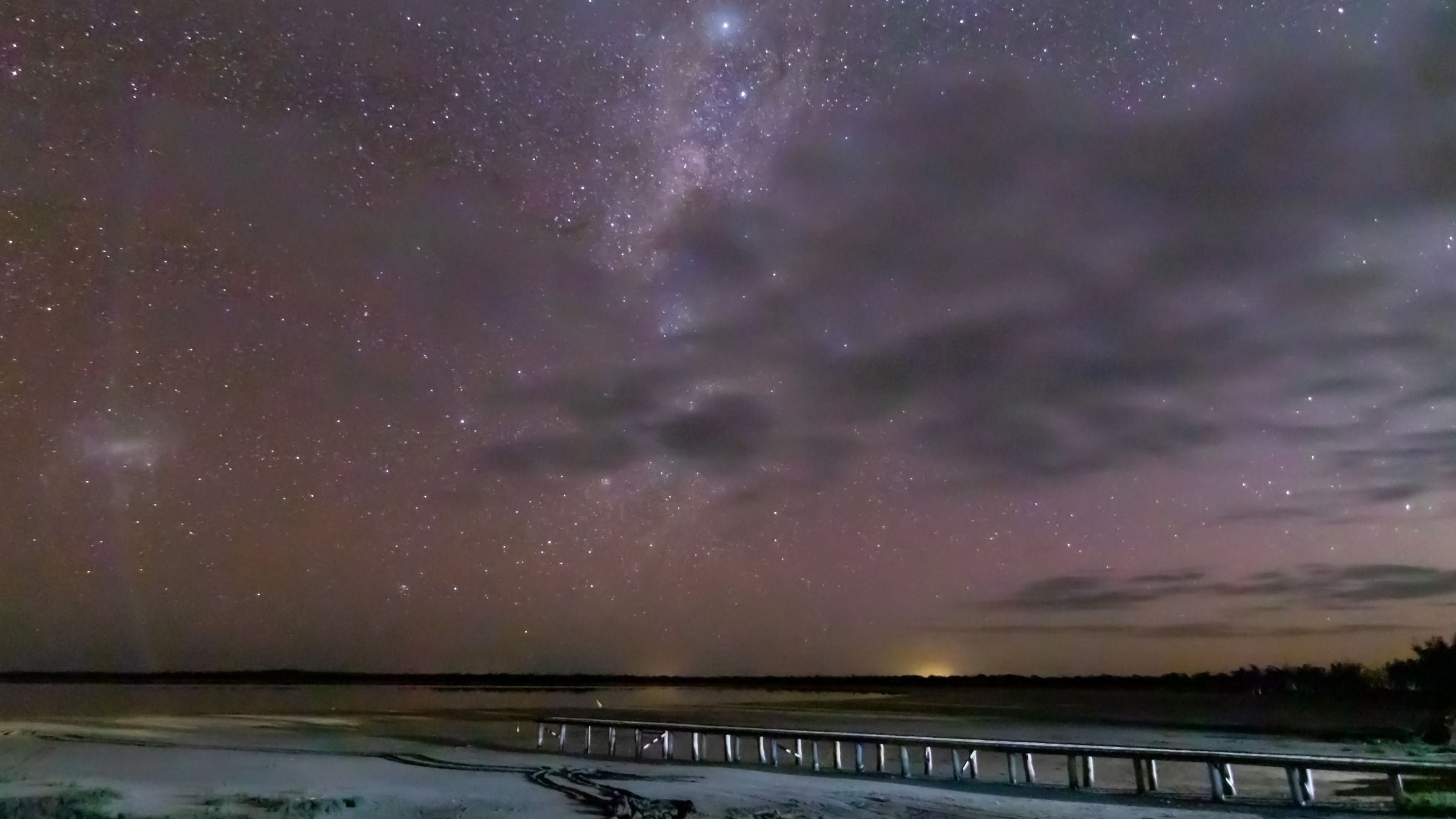
TAFE Students Put Regional WA on Dark Sky Tourism Path
Students studying Travel and Tourism at Perth’s North Metropolitan TAFE have worked with five Astrotourism Towns in regional WA to develop innovative visitor packages. The Dark Sky Tourism Product Development Project is an initiative between North Metropolitan TAFE...

Astrofest Astrophotography Exhibition Opens for Entries
Entries to the 2023 Astrofest Astrophotography Exhibition have opened and will culminate with an Awards ceremony at the popular Astrofest event to be held in Perth on 18th November. All West Australians interested in photographing the night sky are encouraged to...

2023 Astrofest Astrophotography Competition Open for Entries
Have you got a GREAT astrophoto in your collection? The 2023 Astrofest Astrophotography Competition and Exhibition is open for entries! The competition is open from 28th July and closes at midnight on 13th August 2023. There are a variety of competition categories you...

Kids in Space Win
Two primary schools from WA’s Astrotourism Towns communities have exhibited 3D modelling designs that create innovation for sustainable space development. Gascoyne Junction Remote Community School displayed concepts for the reduction of light pollution to ensure...
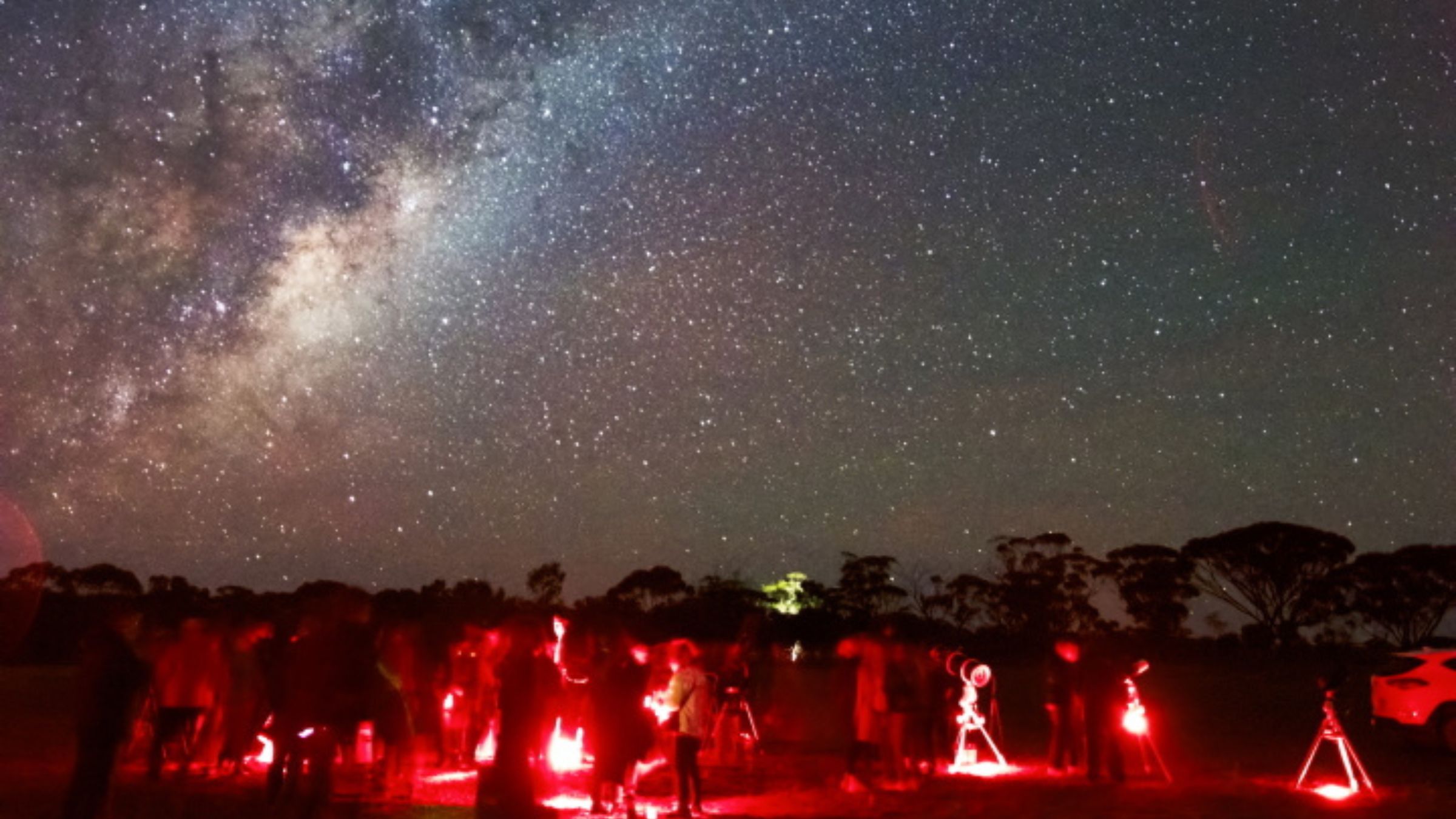
Stargazing Discovery Tour to promote dark sky tourism to eclipse chasers
Astrotourism WA has released a series of 22 dark sky stargazing events to celebrate the Ningaloo Total Solar Eclipse and promote Western Australia’s world-class night sky to eclipse chasers and visitors from around the world. The Eclipse Discovery Tour dark sky...
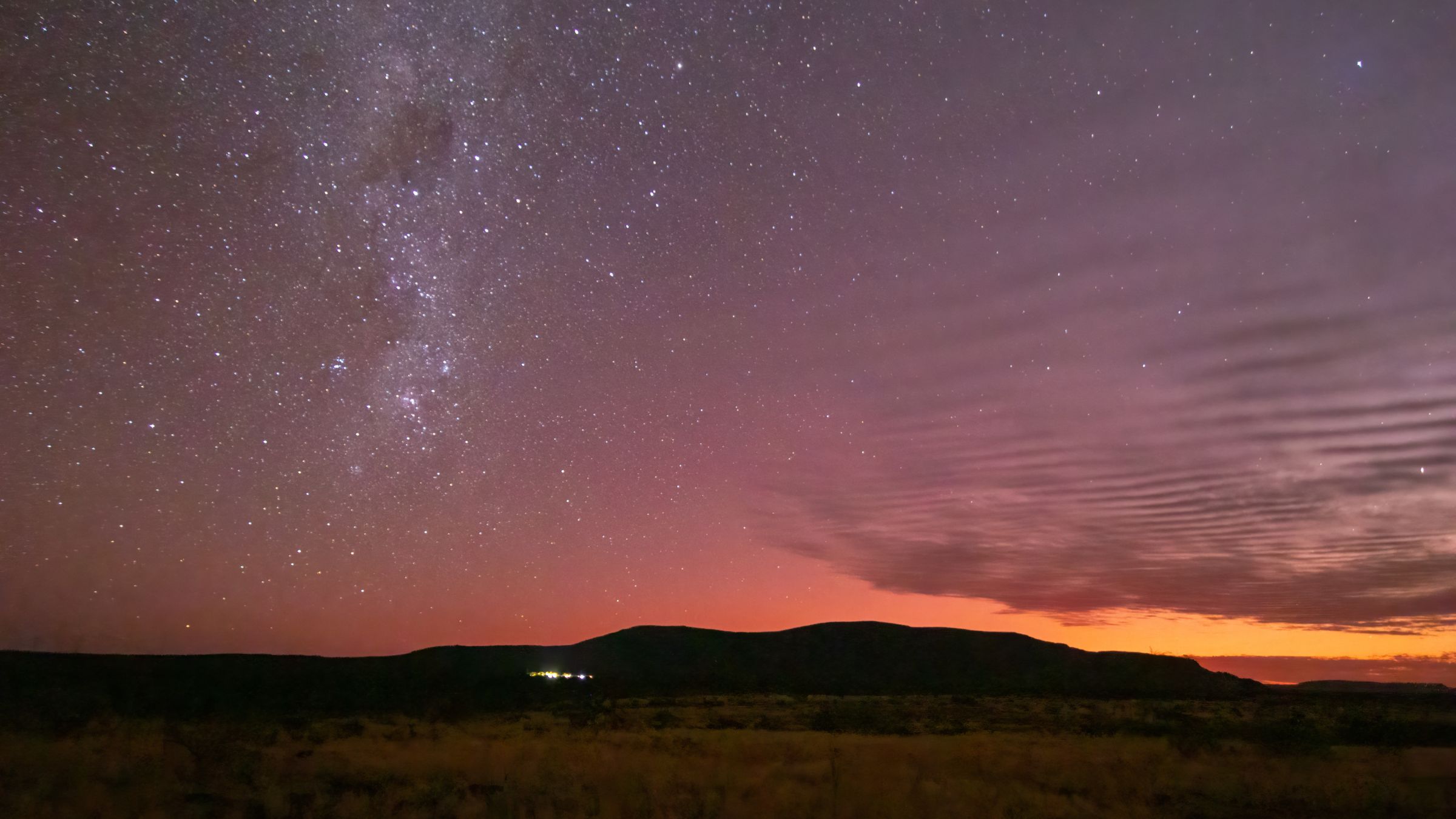
Starry Coast to Outback Adventure | 17 Days | Gascoyne
Breathtaking outback and coastal adventures await in the amazing Gascoyne region. The stars sparkle overhead, and the spectacular landscape will take you to another world. There is lots on offer for visitors – from gourmet produce and fun in Carnarvon, to outback 4WD...

Winners 2022 Astrofest Astrophotography Competition
The 2022 Astrofest Astrophotography Competition and Exhibition was a huge success! There were 380 entries from 76 different entrants and the winners of seven awards were announced at Astrofest on 29 October 2022. Astrotourism WA sponsors the trophy for the Best...

Star Way | 10-12 Days | Pilbara
The wide-open starry night sky landscapes across the Shire of Ashburton in the Pilbara will take your breath away. Hit the open road and discover sunrises, sunsets and everything in between across Western Australia's North West. From the protected boating waters...

Rocks Stars | 14 Days | Murchison
Murchison brilliant starry night skies and ancient rock formations will captivate your every sense. The night sky and land have a connection like nowhere else on Earth. Time stands still and you can feel the ancient wisdom of the world’s first astronomers, Aboriginal...
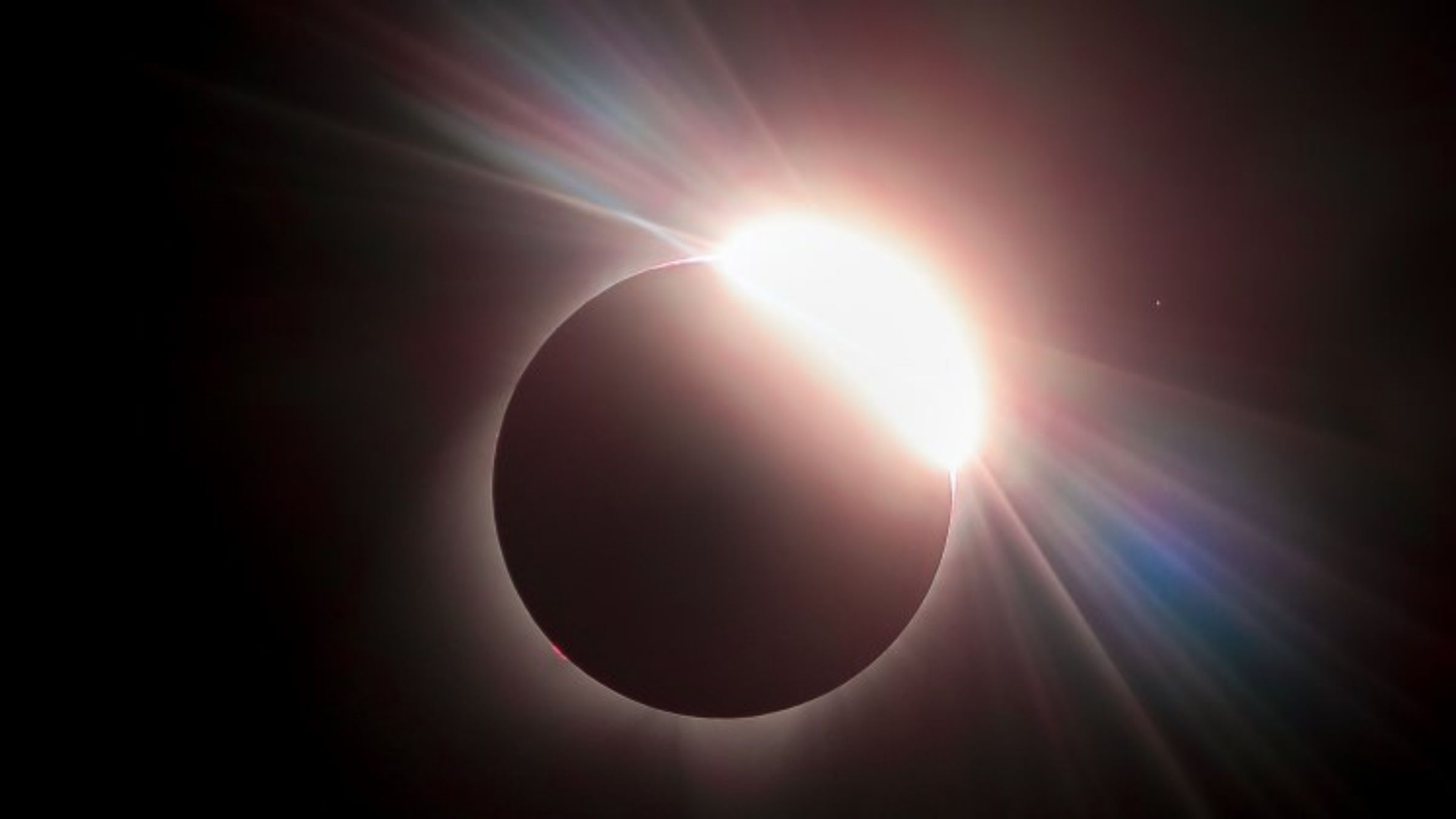
WA Eclipse One Year Countdown Begins
One year from now, Western Australia will be the best place on the planet to witness a total solar eclipse. On 20 April 2023, the area around Exmouth and the Mackerel Islands will be buzzing with visitors read to see one of nature’s most incredible shows. Tens of...

2024 Solar Eclipse

Day 1 | April 5
- Arrive in Dallas and transfer to your 4-star hotel in the heart of downtown Dallas.
- In the evening, enjoy a welcome reception and dinner with your group in town.
Day 2 | April 6
- Breakfast at the hotel.
- Spend the day exploring local museums and other key sites.
- Visit the Perot Museum of Nature and Science where we will receive a private guided tour and discussion in “Expanding Universe” Hall.
- After our group lunch, we’ll transfer to the University of Texas at Arlington’s Planetarium, one of the three largest planetariums in Texas, where we’ll receive a private viewing of what to expect on eclipse day.
- Enjoy a dinner with local alumni tonight.
Day 3 | April 7
- After breakfast, we’ll transfer to the Noble Planetarium, one of the nation’s top spots for stargazing, where we will receive a private tour and lecture within the newly renovated Noble Space Gallery.
- Enjoy lunch with the group nearby before transferring to our private eclipse-viewing accommodations, at Summers Mill Retreat, about 2 hours from Dallas.
- Free time to settle in, explore the property, and participate in some nature activities.
- In the evening, our astronomy expert will prepare us for the incredible phenomenon we’re all about to witness tomorrow. Savor a traditional Texan dinner with the group.
Day 4 | April 8
- Today’s the day! After breakfast, participate in some fun celestial games and prep activities. Enjoy an early lunch before the big moment, with totality occurring at 1:38pm.
- In the late afternoon, we’ll head over to nearby Waco to participate in some of the festivities the city is putting on in honor of the eclipse.
- Final farewell dinner with the group.
Day 5 | April 9
- After breakfast, enjoy some of the morning to soak up one more nature activity before the group transfers back to Dallas for your return flights home.
Activity-Level Rating: 2
Accommodation
Fairmont dallas, summers mill retreat center, what's included.
- Accommodations for 4 nights
- All meals mentioned in the itinerary
- All listed activities and excursions
- All listed transfers
- Private visit to Perot Museum of Nature and Science and the Noble Space Gallery
- Specially designed eclipse viewing glasses
- Arrival and departure transfers
- Travel insurance
- Any meals/drinks not specifically mentioned in the itinerary
- Expenses of a purely personal nature
- Like us on Facebook @caldiscoveriestravel
- Follow us on Instagram @caldiscoveries
SECURE YOUR PLACE
- A Group of Luxury Catamarans
- A Skipper and Private Chef for Each Boat
- 3 Days of Sailing
- Water Activities and Unbelievable Sunsets

- Skip to global NPS navigation
- Skip to this park navigation
- Skip to the main content
- Skip to this park information section
- Skip to the footer section

Exiting nps.gov
Alerts in effect, death valley dark sky festival.
Last updated: March 4, 2024
Park footer
Contact info, mailing address:.
P.O. Box 579 Death Valley, CA 92328
760 786-3200
Stay Connected
- US 1-800-830-1998
- 1-928-445-7754
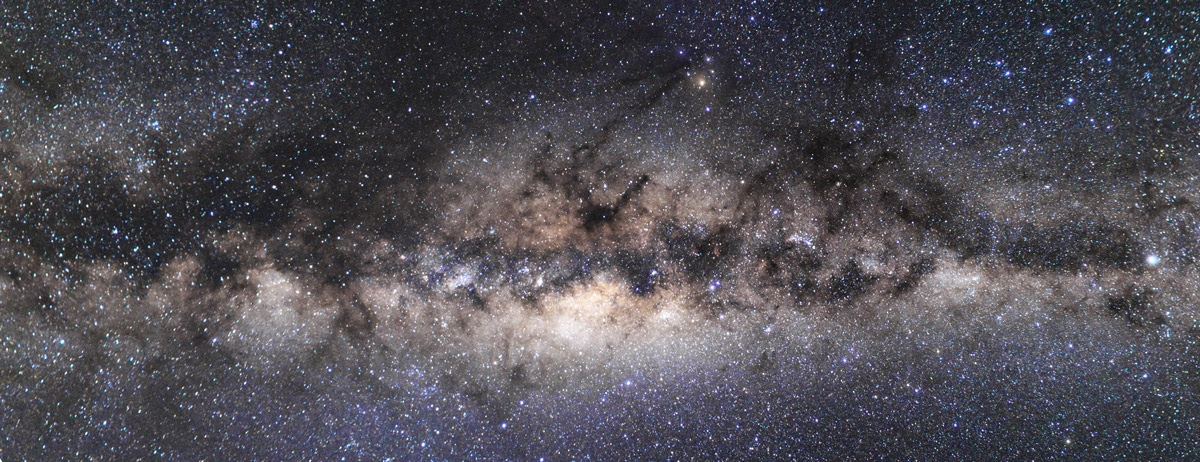
Stargazing Travel
Many of us live in urban environments, enveloped by light. For us, the night sky has vanished. Yes, there’s the Moon, a planet or two, and a few bright stars are visible. Maybe you can even find the seven stars of the Big Dipper from your backyard or balcony. But usually, when viewed from a light-filled city, the sky is pretty much starless. Even if you escape to a nearby state, provincial, or national park, the sky scene isn’t much better. Urban lights cast a long glow.
In a dark night sky, the stars literally jump out at you, and you can easily become lost in the heavens. Where are the constellations? What are the names of those numerous bright stars? And wouldn’t it be nice to look through a telescope at some of the celestial sights.
That’s where a stargazing vacation with TravelQuest comes in. Not only do we take you to a very dark location, we have an astronomer with us to help you navigate the heavens and explain what you’re looking at. We often bring telescopes with us, so you can get close-up views of assorted double stars, star clusters, nebulas, and even a few galaxies.
Explore this and other types of eclipse travel
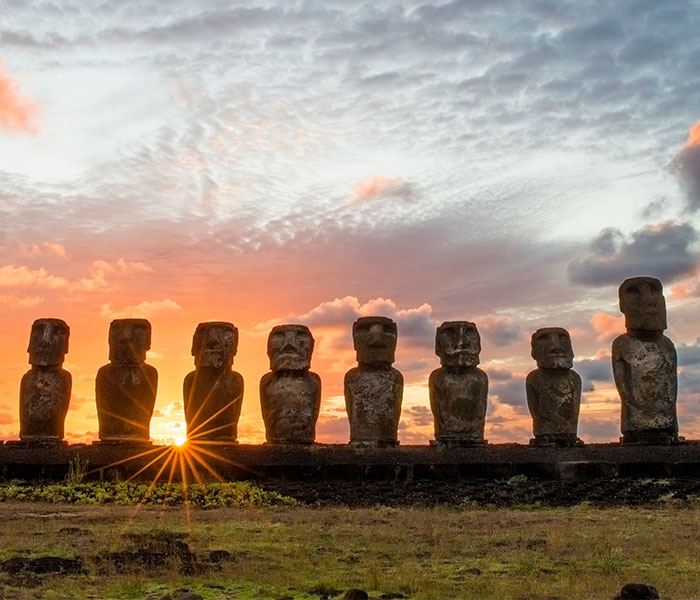
Atacama Desert & Easter Island Annular Eclipse
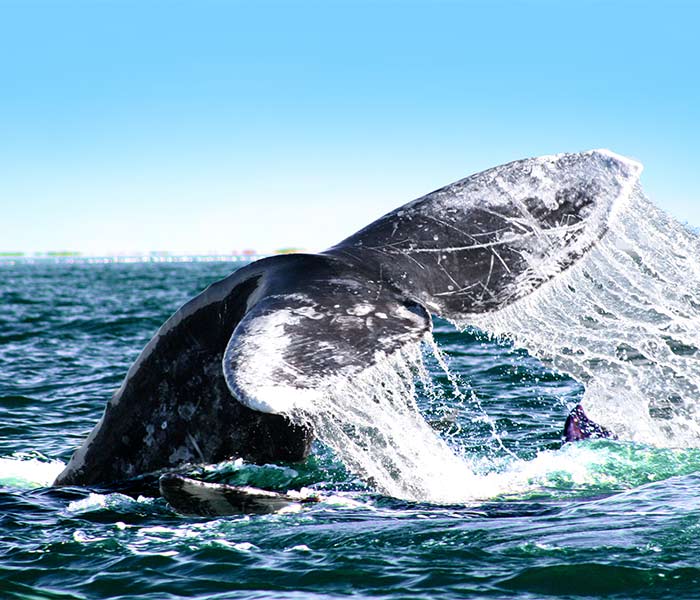
Baja California Whale Watching & Stargazing Adventure

2026 Greenland & Iceland Total Solar Eclipse Cruise

2026 Spain Total Solar Eclipse Tour
A Feast for the Senses

2026 Iceland Total Solar Eclipse
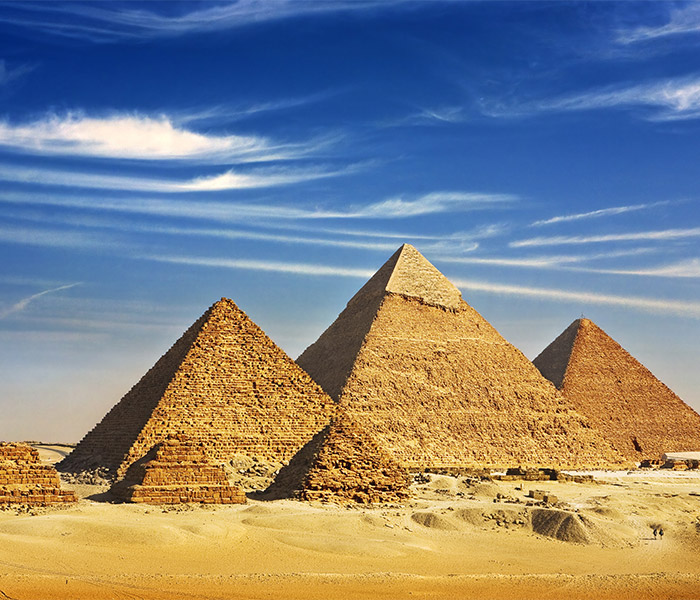
Iconic Egypt Total Solar Eclipse
An unforgettable trip.
What makes a stargazing trip to a dark-sky site so enjoyable? It connects you with the universe—nature on a grand scale. For many, there is great pleasure in simply standing beneath a dark, crystal-clear sky, gazing up and out into the cosmos. Far from city lights, the night sky shines with a light show of its own, a show highlighted by the naked-eye spectacle of the glowing Milky Way.
With stargazing, there is no need to rush; it’s a very tranquil pastime. Given the hectic pace of modern life, it’s extremely pleasant to be able to just kick back, relax, and connect with the universe—and with yourself. You’ll also connect with other, like-minded travelers who share your interest in the night sky. Our stargazing trips are small-group tours, and you’ll quickly become friends with your fellow stargazers, some of whom are repeat travelers.
You don’t need to know a thing about the night sky. Our trip astronomer will introduce you to the heavens, point out some of the finest sights, and help you get the best out of any equipment we have with us. No need to bring a telescope, though if you have binoculars, do take them.
From Costa Rica—the dark-sky site that we travel to most often—the Milky Way, our galactic home in the universe, is prominent. In spring, beautiful sky sights such as Crux (the Southern Cross), the brilliant Jewel Box star cluster, the pretty Eta Carinae nebula, the magnificent Omega Centauri globular star cluster, and the Large Magellanic Cloud (a neighboring galaxy) are in view at various times of the night.
Our stargazing trips to Iceland (and occasionally Norway) are a little different, as we’re there primarily in search of the aurora borealis, the northern lights. Here, the northern sky dominates, but because we go in early autumn, the intriguing winter stars rise late each evening, including the pretty Pleiades star cluster, the Orion nebula, numerous open star clusters, and more bright stars than are visible during any other season.
While we’re outside stargazing, we may be favored with an occasional unexpected sighting. A sporadic meteor might flash across the heavens, or we may spot a number of artificial satellites as they orbit Earth. Even the International Space Station might put in an appearance.
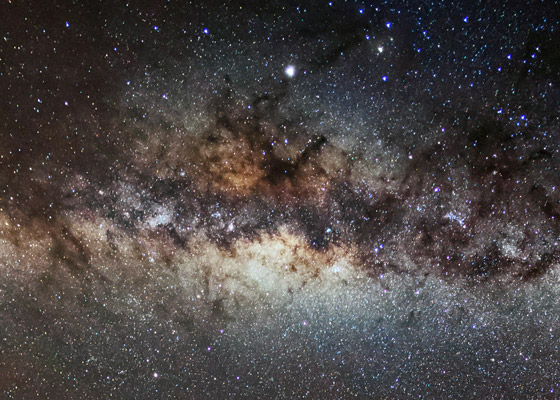
Why Go On a Stargazing Vacation?
Stargazing is extremely relaxing. There’s no rush, no stress, no competition. While on a stargazing vacation with TravelQuest, you connect with others who share your interest in the night sky. Our stargazing tours are small-group travel at its best. You’ll learn about the heavens by observing the sky and chatting with our trip astronomer.
Stargazing holidays with TravelQuest are about more than the stars. Our dark-sky sites are also interesting locales to explore during the day. Each year, when we travel to Costa Rica, we enjoy views of the splendid southern sections of our Milky Way galaxy. During the day, we explore this central American country known for its rich biodiversity and dramatically varied landscapes.
Another one of our stargazing destinations is Iceland. Here, our prime objective is the dancing celestial lights known as the aurora borealis. So we stay at remote hotels or guesthouses with dark skies and quick access to the outdoors. While waiting for the aurora, we survey the northern heavens, with our trip astronomer pointing out the constellations and their brightest stars. During the day, the magnificent Icelandic countryside spellbinds us with its waterfalls, volcanoes, lava fields, and hot springs.
Due to demand, TravelQuest is adding more stargazing vacations. In the summer, we’ll head to Hawaii and the observatories on Maunakea (the Hawaiian spelling of Mauna Kea). Here we’ll stargaze from the Onizuka Visitor Center, located at 9,300 ft (2,800 m) elevation. We are also planning a spring trip to Baja, California, to see gray whales in Magdalena Bay. On clear nights we’ll observe from the deck of our ship and have two nights of observing from a dark-sky site on land.
All of our stargazing trips combine night-sky viewing from sites free from light pollution with fascinating landscapes that we explore during the day. It’s a mixture that’s hard to beat.
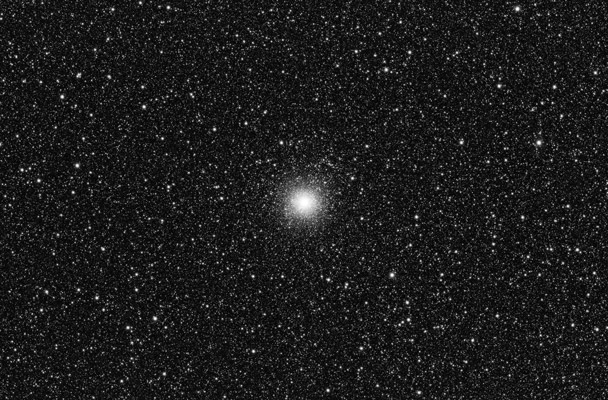

Join TravelQuest Under the Stars
If you’ve never gazed in awe at a dark, star-speckled night sky, or swept your eyes across the dark dust lanes and millions of stars of our Milky Way galaxy, then you’re in for a real treat. Join us, and make your next holiday a stargazing holiday. We’ll take you to a dark-sky site, where (weather permitting) our astronomer will guide you through the heavens and describe what you’re seeing. We’ll often have telescopes with us, so you can get closer views of some of the beautiful celestial sights found throughout our galaxy.
A stargazing holiday is wonderfully relaxing. It puts you in touch with the universe—it’s nature on the largest scale possible. Sometimes, you won’t believe your eyes. If this sounds appealing, contact TravelQuest today to learn more about one of our upcoming stargazing vacations.
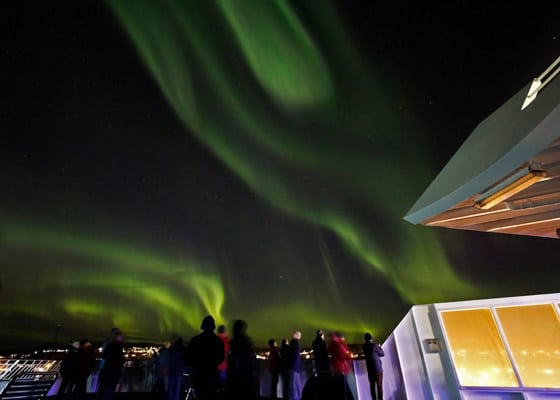
Header image by European Southern Observatory/B. Tafreshi ( twanight.org )
Learn More About Stargazing Travel

Like what you see?
Enter your name and email below to sign up for future tour updates.
Your review Your overall rating Select a Rating 5 Stars 4 Stars 3 Stars 2 Stars 1 Star Title of your review Your review Your name Your email This review is based on my own experience and is my genuine opinion. Submit your review
We have completed maintenance on Astronomy.com and action may be required on your account. Learn More

- Login/Register
- Solar System
- Exotic Objects
- Upcoming Events
- Deep-Sky Objects
- Observing Basics
- Telescopes and Equipment
- Astrophotography
- Space Exploration
- Human Spaceflight
- Robotic Spaceflight
- The Magazine
Trips & Tours
Travel the world with astronomy magazine and eclipse traveler..

The 2024 Eclipse Experience by Discovery Institute
You’re invited.
Nothing compares to the otherworldy experience of witnessing a total solar eclipse in person.
A drop in temperature, a 360-degree sunset, a silvery sheen in the sky, stars and planets strangely visible mid-day, insects and birds behaving erratically, shadows becoming distorted…it is truly one of the greatest shows on Earth.
Beyond the unique sensory experience lies something even more astonishing — a cosmological coincidence of metaphysical significance to human existence and the scientific enterprise.
Discovery Institute is pleased, then, to invite you to join us in the Dallas–Fort Worth metroplex on April 7-8, 2024 for a one-of-a-kind eclipse experience , when the “path of totality” will pass directly over our event venue. Southwestern Assemblies of God University (SAGU) has kindly offered the use of their auditorium and soccer field for our event due to the proximity of their Waxahachie campus to the center line (in green, below) of the path of totality (in yellow).
Our prime location will afford 2 hours and 40 minutes of viewing (12:22 – 3:02 pm) and 4 minutes and 19 seconds of totality (1:39:47 – 1:44:06 pm) — one of the best (and most accessible) viewing locations in the U.S. and almost double the maximum totality of the last total solar eclipse over North America on August 21, 2017.
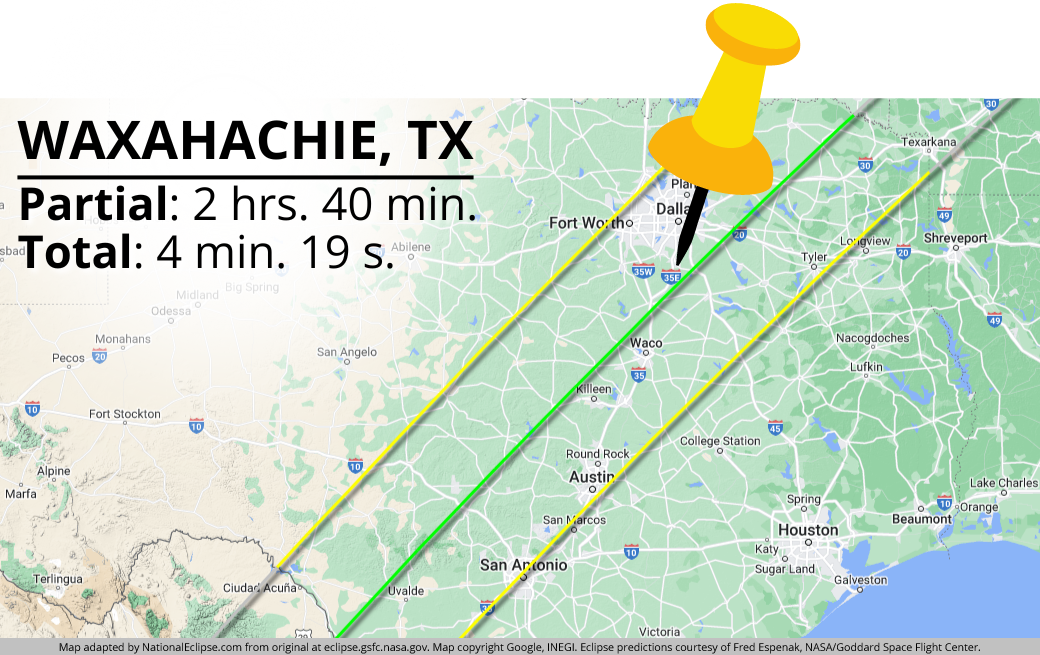
What to expect
Setting the stage on the evening prior, accomplished astrobiologist Guillermo Gonzalez and philosopher of science Jay Richards will unpack the importance of total solar eclipses in a public lecture hosted by SAGU. They’ll cover both the key arguments from their co-authored book The Privileged Planet (Regnery Publishing, 2004) as well as new discoveries and insights soon to be highlighted in their 20th-anniversary edition scheduled to release later in the year.

Back on campus on Monday afternoon, these two presenters will then guide viewers through the total solar eclipse experience on the football field at SAGU. They’ll prepare you to look for unusual phenomena leading up to the eclipse, provide an immersive silence during the ~4 minutes of totality , and then wrap up with some brief takeaways from this experience.
The whole sensory experience will be one that you’ll remember for the rest of your life, and the lessons learned will be of surprising significance to your understanding of our place in the cosmos.
More details
Registration is required and we highly encourage attendees to plan ahead and arrive on campus early. Traffic in the metroplex is expected to reach peak heights around the time of the eclipse, so it’s important to build in this buffer so that you don’t end up viewing this brief and rare encounter from your car as you sit in gridlock traffic!
Complimentary eclipse viewing glasses will be provided for all those who register for the Monday viewing and cannot be guaranteed for walk-up attendees.
For those visiting from out of town, a discounted block of rooms has been arranged at two Dallas-area hotels. Details are available below.
Why choose Discovery Institute’s event?
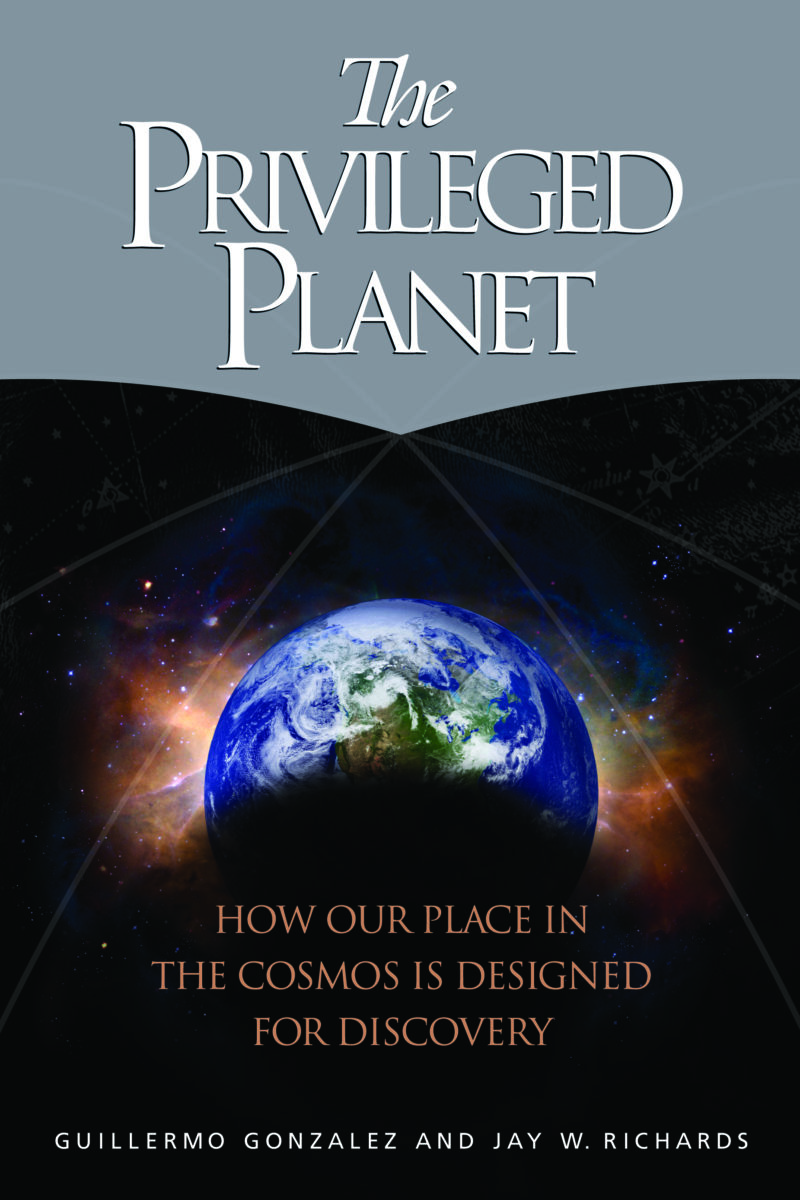
Total solar eclipses have been a focal point of Discovery Institute’s Center for Science & Culture since at least 2004 when the release of the aforementioned The Privileged Planet opened with a detailed exploration of these rare-in-the-universe astronomical occurrences. The book (and documentary film adapted shortly thereafter) explored the finely-tuned conditions on Earth that allow for the existence of intelligent life and also make it strangely well-suited for viewing and analyzing the rest of the universe.
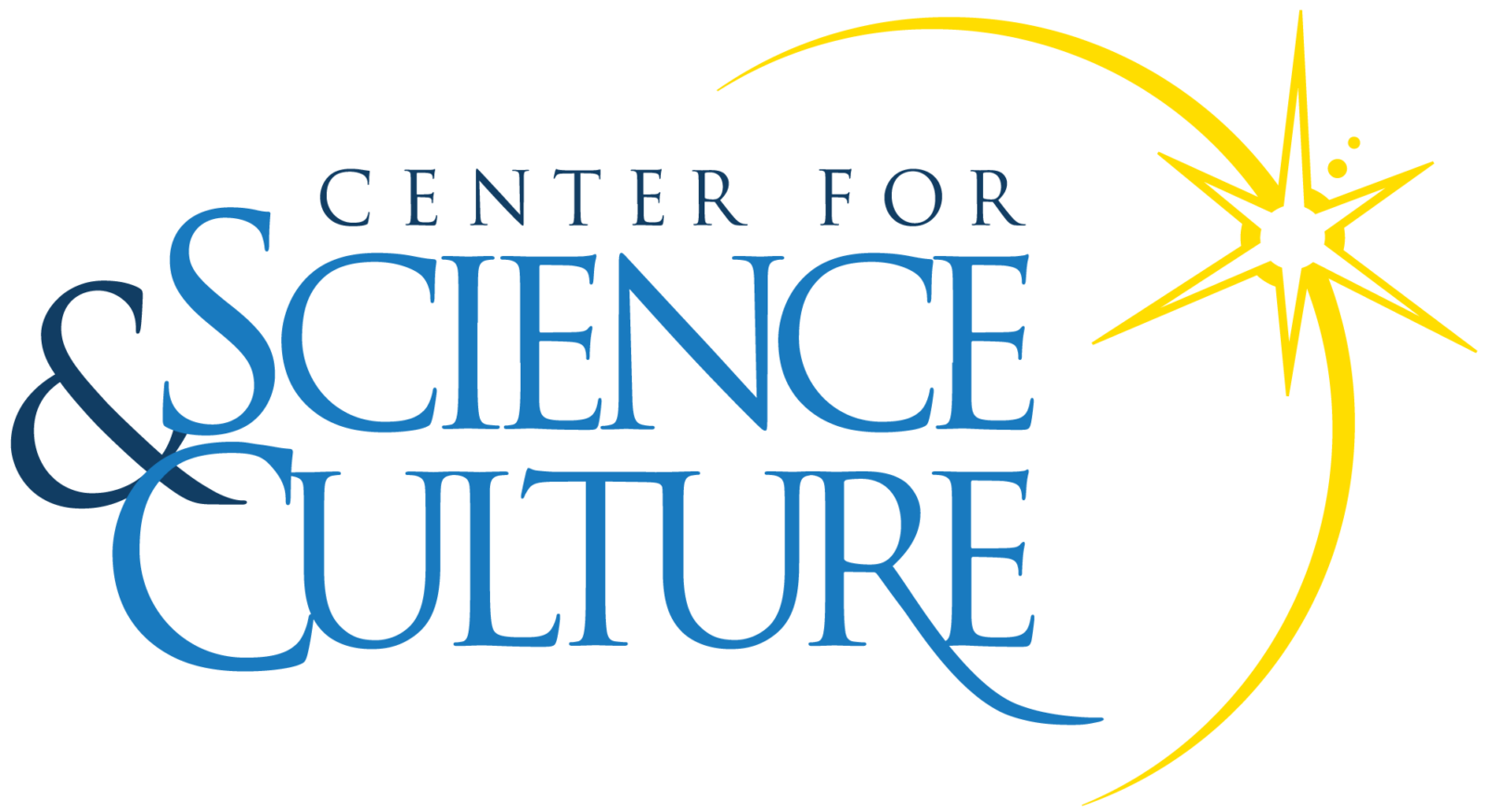
For over two decades, the Center for Science & Culture logo has featured the total solar eclipse (in yellow, here) to represent the fine-tuning of the Earth and cosmos for both life and scientific discovery. Eclipses are also highlighted throughout our programming, especially as we look forward to hosting multiple conferences and events with cosmological themes in 2024.
Sunday, April 7 , 7:00–8:30 pm Monday, April 8 , 12:00–2:00 pm
Sheaffer Center SW Assemblies of God University 1260 Savell Circle Waxahachie, TX 75165
Pam Bailey Dallas Operations Manager [email protected]
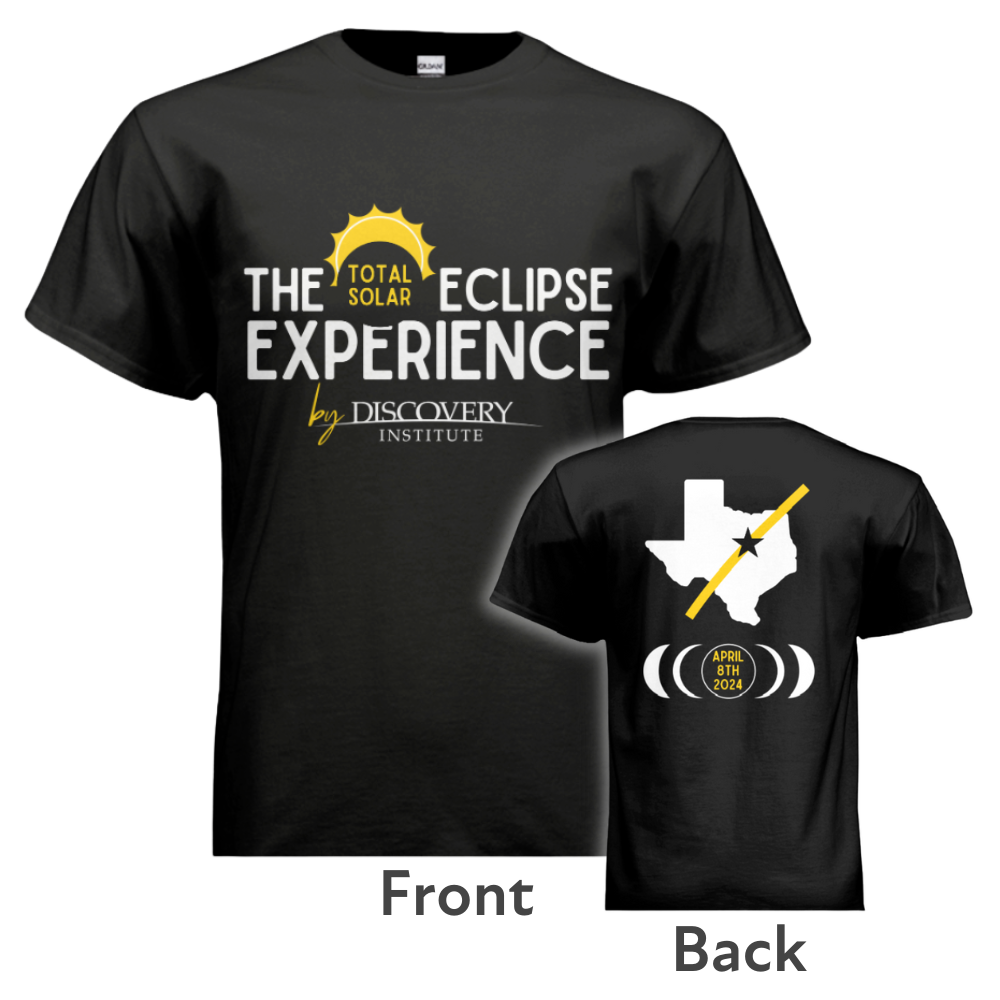
Comfort Inn & Suites Cedar Hill Duncanville
1419 N. US Highway 67 Cedar Hill, TX, 75104
PRICE: $149.00 (+ tax) PHONE: 469-575-5620 DISTANCE: 24.1 miles from Southwestern Assemblies of God University, 21 miles from Dallas Love Field airport
GROUP RATE INFO: Use the link below or reference the Discovery Institute group rate when booking by phone.
Book Your Room Now

Crowne Plaza Dallas Downtown
1015 Elm Street Dallas, TX 75202
PRICE: $159.00 (+ tax and self-parking $20 a night) PHONE: 214-742-5678 DISTANCE: 27.9 miles from Southwestern Assemblies of God University, 6 miles from Dallas Love Field airport

Holiday Inn Express & Suites North Dallas at Preston
6055 LBJ Freeway Dallas, TX 75240
PRICE: $139.00 (+ tax, $5.00 a day parking fee) PHONE: 972-404-4500 DISTANCE: 38.7 miles from Southwestern Assemblies of God University, 9.6 miles from Dallas Love Field airport
Guillermo Gonzalez
Jay w. richards.

Ride the Wave of Radio Astronomy During the Solar Eclipse
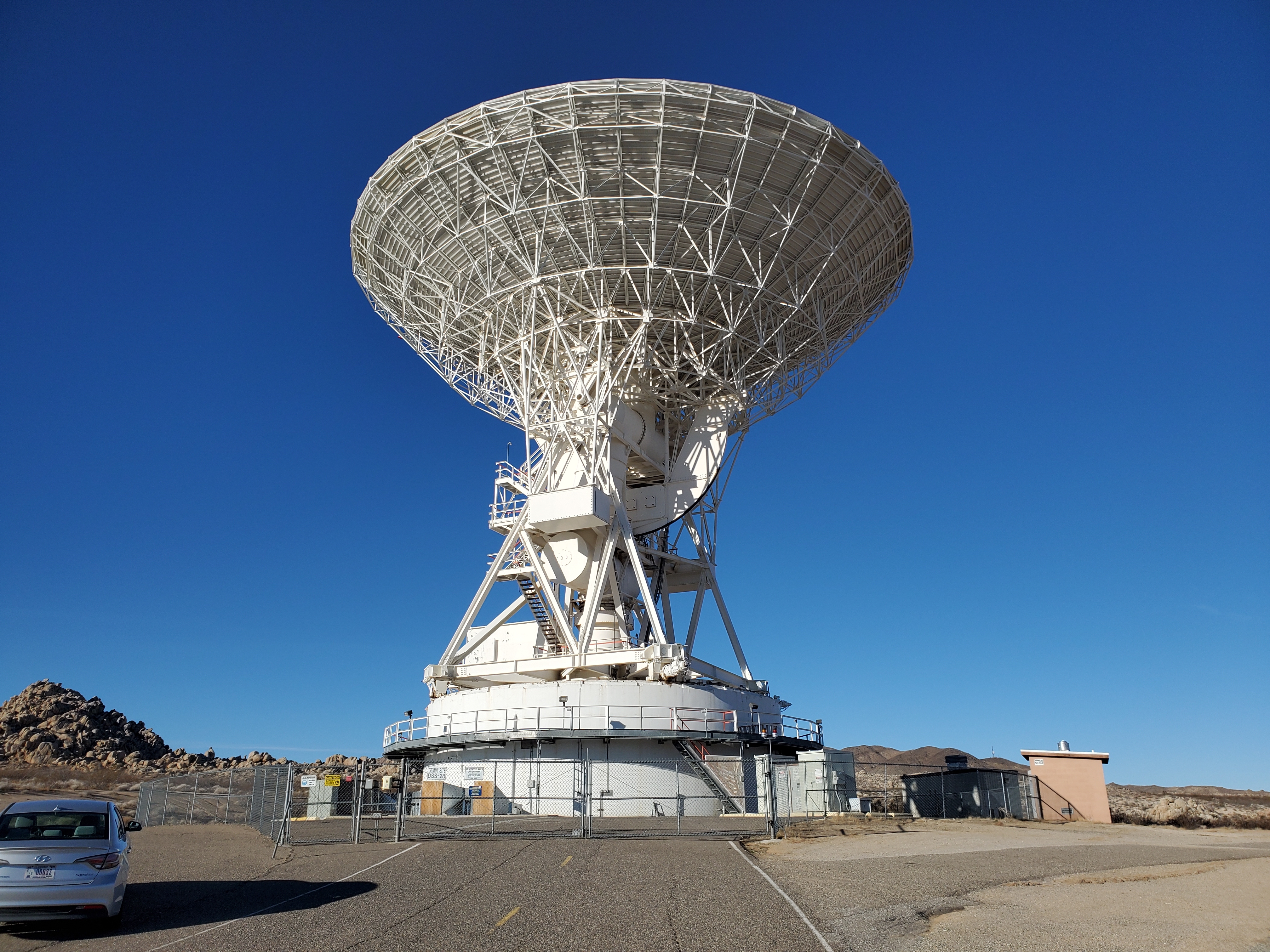
Students and science enthusiasts are invited to catch a real-time look at radio astronomy as scientists explore magnetic hotspots on the Sun during a live, virtual solar eclipse event on April 8, 2024.
A massive, 34-meter telescope once used by NASA’s Deep Space Network to communicate with spacecraft will point towards the Sun during the solar eclipse that day. The Moon’s position in front of the Sun will help the antenna detect radio waves from solar active regions in more detail than is usually possible.
The Solar Patrol team at California’s Lewis Center for Educational Research, in partnership with NASA’s Jet Propulsion Laboratory, will remotely operate the Goldstone Apple Valley Radio Telescope (GAVRT) while sharing observations and commentary during an interactive webinar open for the public.
Scientists and students regularly use the single-dish GAVRT antenna, located in the Mojave Desert of California, to scan the Sun. They use the observations to build maps of radio waves formed along strong magnetic field lines in the outer atmosphere of the Sun. By studying these images, researchers can measure the strength and structure of those powerful magnetic regions. These observations offer insight into magnetically driven processes on the Sun, like solar flares and coronal mass ejections, which generate space weather events that can interfere with satellite electronics, radio communications and GPS signals, spacecraft orbits, and power grids on Earth.
During normal solar observing, GAVRT can only detect and distinguish relatively large features on the Sun. A solar eclipse offers a unique opportunity for GAVRT to capture sharper and more refined information about the magnetic field structure in the solar active regions that are often marked by sunspots.
“It’s special during the eclipse because, as the Moon is passing in front of an active region, that really sharp edge of the Moon covers up more and more of the structure in that active region,” says Marin Anderson, a research scientist at NASA’s Jet Propulsion Laboratory and GAVRT Solar Patrol scientist.
Anderson explains how, as the Moon blocks a portion of the active region, it's easier to tell what part of the active region the radio emissions are coming from.
“It's basically a way of probing magnetic field structures in the corona of the Sun in a way that we wouldn't be able to unless an eclipse was happening.”
Anyone in the world can join the live-streamed webinar on April 8 from 1-3:30 p.m. EDT (10 a.m. to 12:30 p.m. PDT) and ask the hosts questions as a partial eclipse becomes visible in California. Participants will be able to see the telescope controls, data visualization tools like Helioviewer , incoming radio data, a map of active hot spot regions, and imagery of the eclipsed Sun at radio wavelengths.
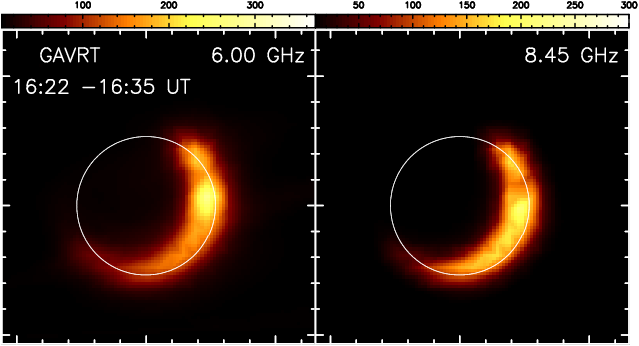
GAVRT was awarded a NASA grant to carry out observations during both the 2023 and 2024 solar eclipses in the U.S. GAVRT supports an open science framework by making all data and radio maps available for viewing and downloading by the public. Images collected during the eclipse will be posted online with instructions on how to run software and analyze the data.
The Solar Patrol team hopes the public webinar inspires people to become active members of the GAVRT program where they can learn to remotely operate the telescope themselves while taking part in data analysis and scientific discovery.
“I think one of the really great aspects of GAVRT Solar Patrol is that it connects any participant, but particularly students, with the Sun, beyond what they see and experience every day from the star,” Anderson says. “It’s seeing the Sun at radio wavelengths and being able to connect different parts of the electromagnetic spectrum with unique physics that's happening on the Sun.”
Since its launch in 1997, GAVRT has offered many opportunities to combine science observations with education and outreach. In addition to Solar Patrol, GAVRT is used in campaigns where participants can study Jupiter’s radiation belts, monitor radio emissions from black holes, or search for extraterrestrial intelligence.
Anderson says giving students the tools to do science themselves empowers them.
“It's a really hands-on process and I think the way to get kids excited and invested in not only solar science but the scientific process in general.”
To register for the GAVRT April 8 eclipse livestream event, visit: https://register.gotowebinar.com/register/4920123655757293655
For other ways to get involved in GAVRT, including signing up a classroom to participate in observations, contact: [email protected] or visit gavrt.lewiscenter.org .
By Rose Brunning, Communications Lead NASA Heliophysics Digital Resource Library
Related Terms
- 2024 Solar Eclipse
- Skywatching
- Solar Eclipses
Discover More on the 2024 Solar Eclipse
Shadow Notes
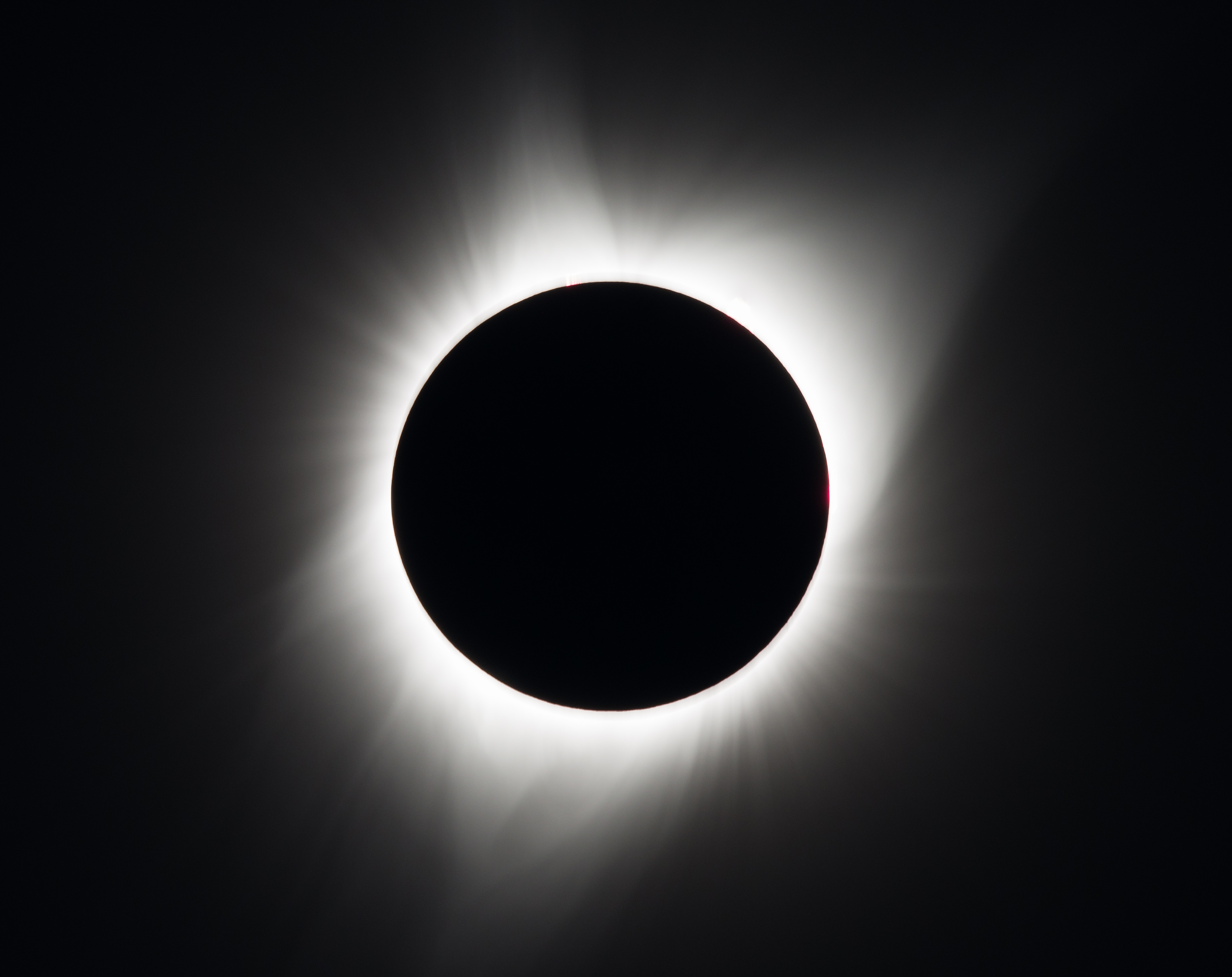
Eclipse 2024 Science
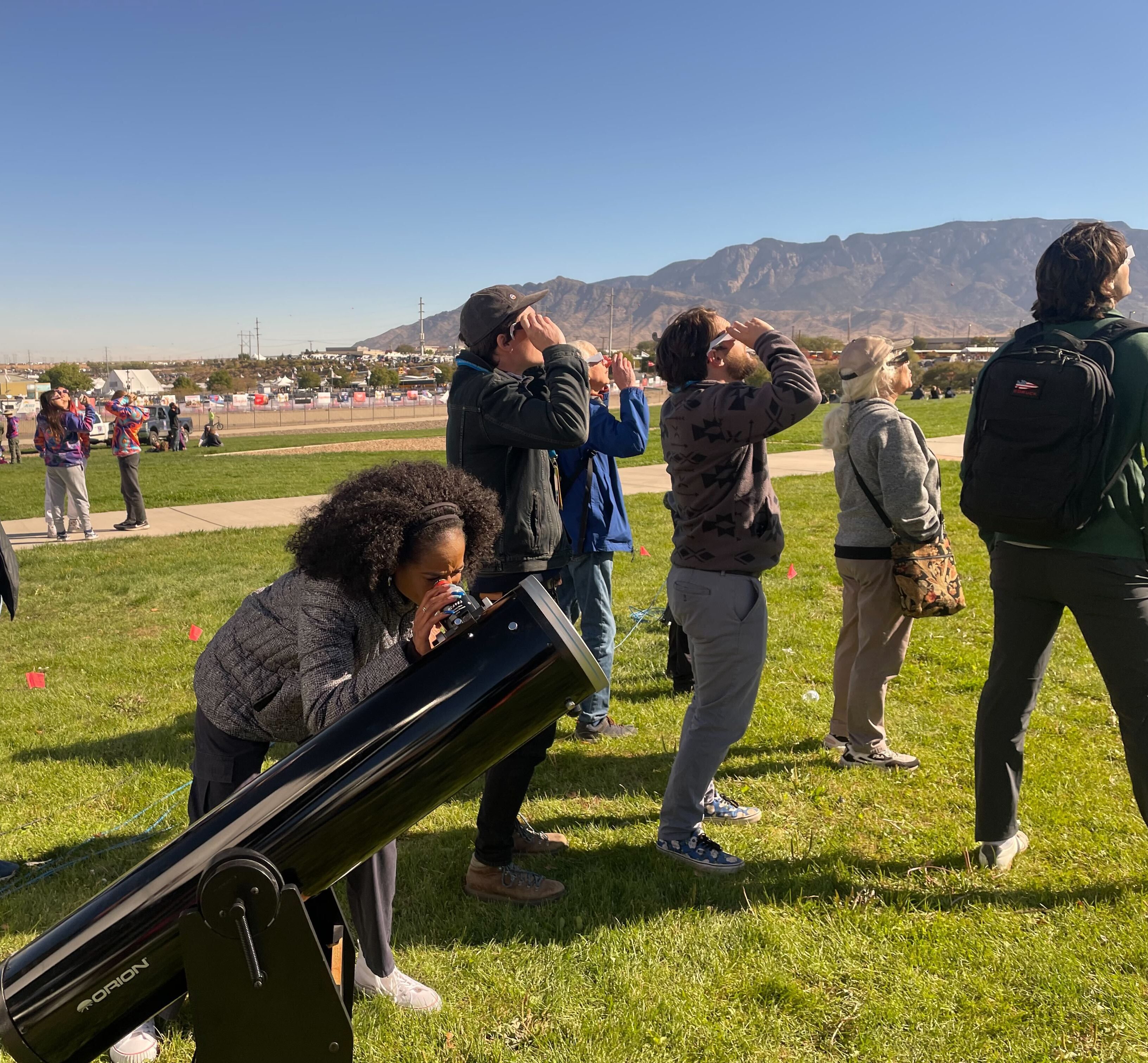
Eclipse 2024 Citizen Science

Total Solar Eclipse Safety
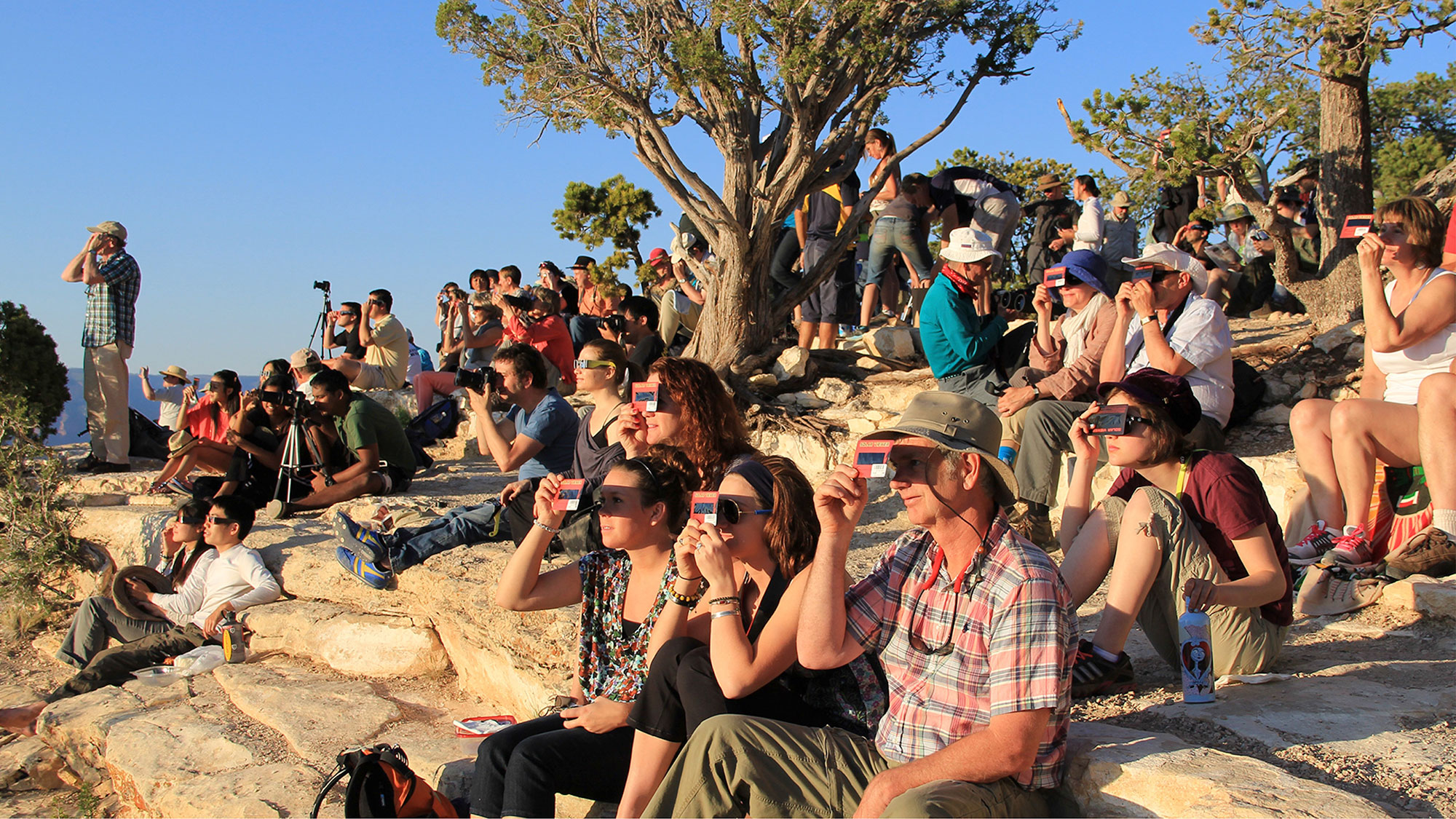
Science facility breaks ground in Fountain Hills during 'incredible' solar eclipse viewing

Gillian Anders made sure to arrive at Centennial Circle in Fountain Hills early. She wanted to make sure she "didn't miss a thing."
Hundreds of people from across the Valley had the same idea as they gathered at the park to witness a solar eclipse on Monday, where 60% of the moon obstructed the sun from view in the region.
While not in the path of totality , Arizonans were still able to catch a glimpse of the moon partially blocking out the sun over Phoenix skies as the eclipse followed a northeast trajectory across North America, beginning a little after 10 a.m. for the Valley and lasting for over 2 hours.
In celebration of the rare phenomenon, a nonprofit organization known as the International Dark Sky Discovery Center, or IDSDC, hosted a mass viewing event near the town's library and museum building, which included distribution of free eclipse glasses, specialized telescopes monitoring the eclipse on a projection screen, a live DJ, and refreshments for guests.
"These kind of things don't happen very often," said Anders, a Chandler resident who brought along her two children and a picnic blanket to enjoy the festivities. "It'll be a long time before we see another one, so I wanted us all to enjoy it while we can."
Husband and wife Russell and Becca Bauer, originally from Texas, were eager to don their own special eclipse viewing glasses that they kept from a past eclipse viewing event that they had attended years prior.
"These kinds of things are pretty incredible to watch," said Russell. "Everyone comes together to watch and it's just fun to be a part of it all."
Coinciding with the eclipse-watching event was a groundbreaking ceremony for a new science facility for IDSDC. With construction scheduled to begin by the end of the month, the 23,000-square-foot project will include several different features, including an observatory, planetarium, theater, exhibits, and an immersion zone. The center is expected to be complete by the fall of 2025.
To commemorate the event, several guest speakers were invited to share their observance of the groundbreaking, including Fountain Hills Mayor Ginny Dickey and state Senator John Kavanagh.
“I want to offer my congratulations on the official groundbreaking of the International Dark Sky Discovery Center," said ASU president Michael Crow in a statement. "This moment marks the physical genesis of a significant, globally impactful site for advancing our understanding of dark skies, and ultimately, our preservation of this important resource."
Additionally, a special blessing of the ground ritual was performed by Raphael Bear, an elder from the Fort McDowell Yavapai Nation.
Joe Bill, the president of the Discovery Center, called the groundbreaking of the new science facility a "momentous event."
"Arizona is becoming a technology state, and we want to do our part to inspire the next generation," said Bill. "If we can accomplish that mission, we are doing a lot to maintain Arizona's reputation as the astronomy state."
Jeff Esposito, the Vice President of the IDSDC, called the project "nine years in the making."
"Ground-based astronomy is a one million dollar industry in Arizona," said Esposito. "We want to be known for something other than just the fountain."
According to Esposito, Fountain Hills was chosen as the site for the new establishment due to its designation as a "dark sky community," meaning that the area experiences little light pollution and promotes astronomical activity for researchers. Fountain Hills was distinguished as a dark sky community in 2018 , making it the 17th community worldwide to be awarded the distinction and only one of two that is near a major metropolitan area.
Promoted as an "international attraction," the facility aims to fulfill its educational mission to support STEM-based programs and to "better understand" astronomy and sustainability efforts, according to Bill. In addition, the IDSDC hopes to raise awareness of the "adverse impacts" of light pollution while highlighting the "multitude of benefits" from dark sky preservation.
"Visitors can expect to be educated and inspired about all the things associated with the night sky," said Esposito.
With a fundraising goal of $25 million, the IDSDC was continuing to seek donations from the community, with naming rights opportunities available for many of the building's major components.
The board of directors project that the IDSDC will offer a variety of cultural and financial opportunities for Fountain Hills and the state of Arizona, such as escalating tourism, partnering with educational institutions, stimulating the local economy, increasing property values, and inspiring future scientists and engineers.
"Guests are going to be wowed by what we have," said Bill. "They are going to be inspired to pursue the sciences."
- Researchers
Buy Tickets
Get all-day access to tours, science talks, stargazing, events, and more.
1400 West Mars Hill Rd
Flagstaff AZ, 86001
Upcoming Holidays
Your Ticket to the Universe
General admission tickets cover all of our programs, including tours and stargazing, from open to close., premium access tickets offer an exclusive, private viewing experience with an advanced telescope..
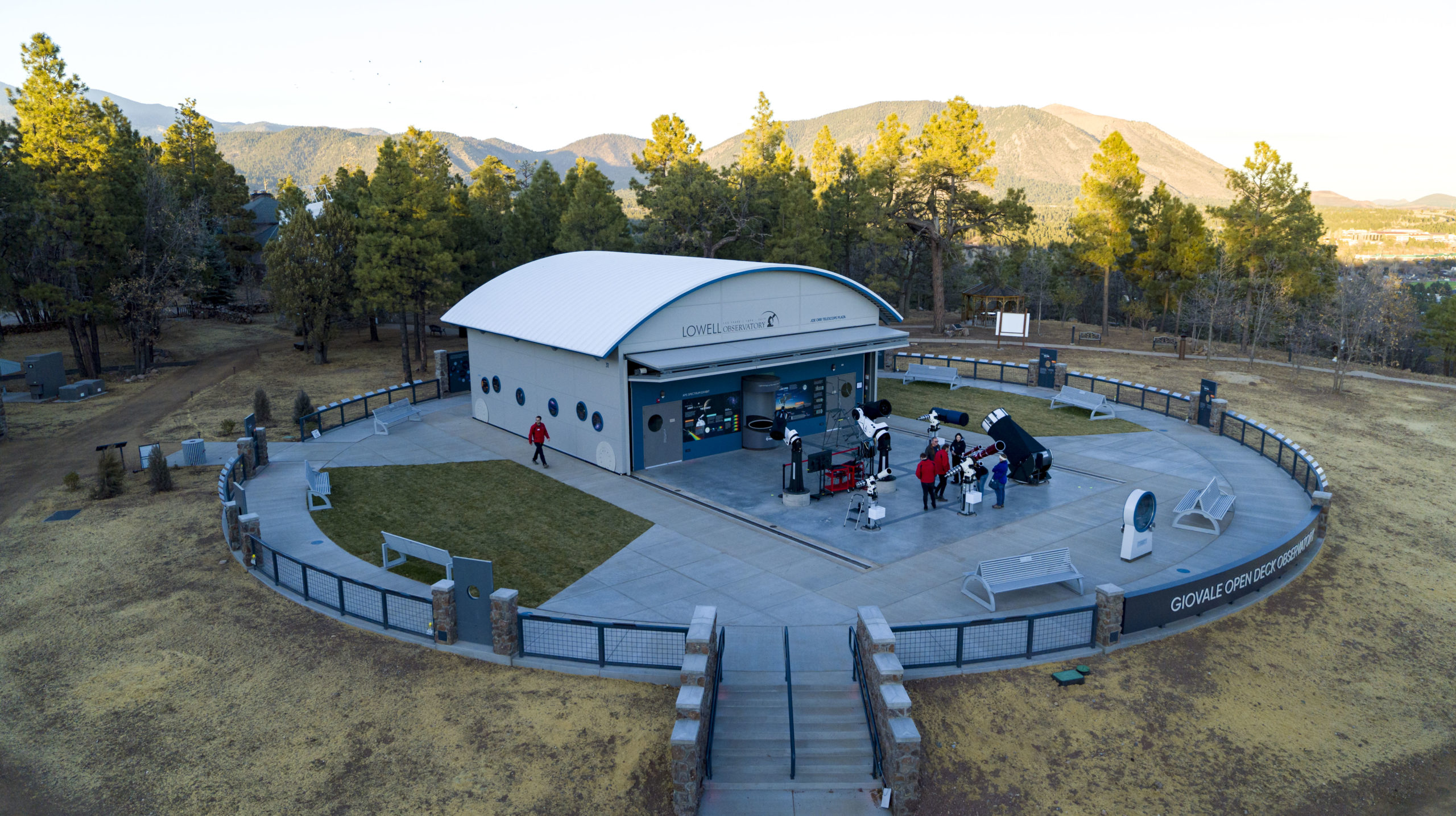
General Admission
All-day access to tours, exhibits, stargazing, science talks, and more.
Wed - Sun: Noon to 10pm
$29 adults (18+) $19 college students
$17 children (5-17)
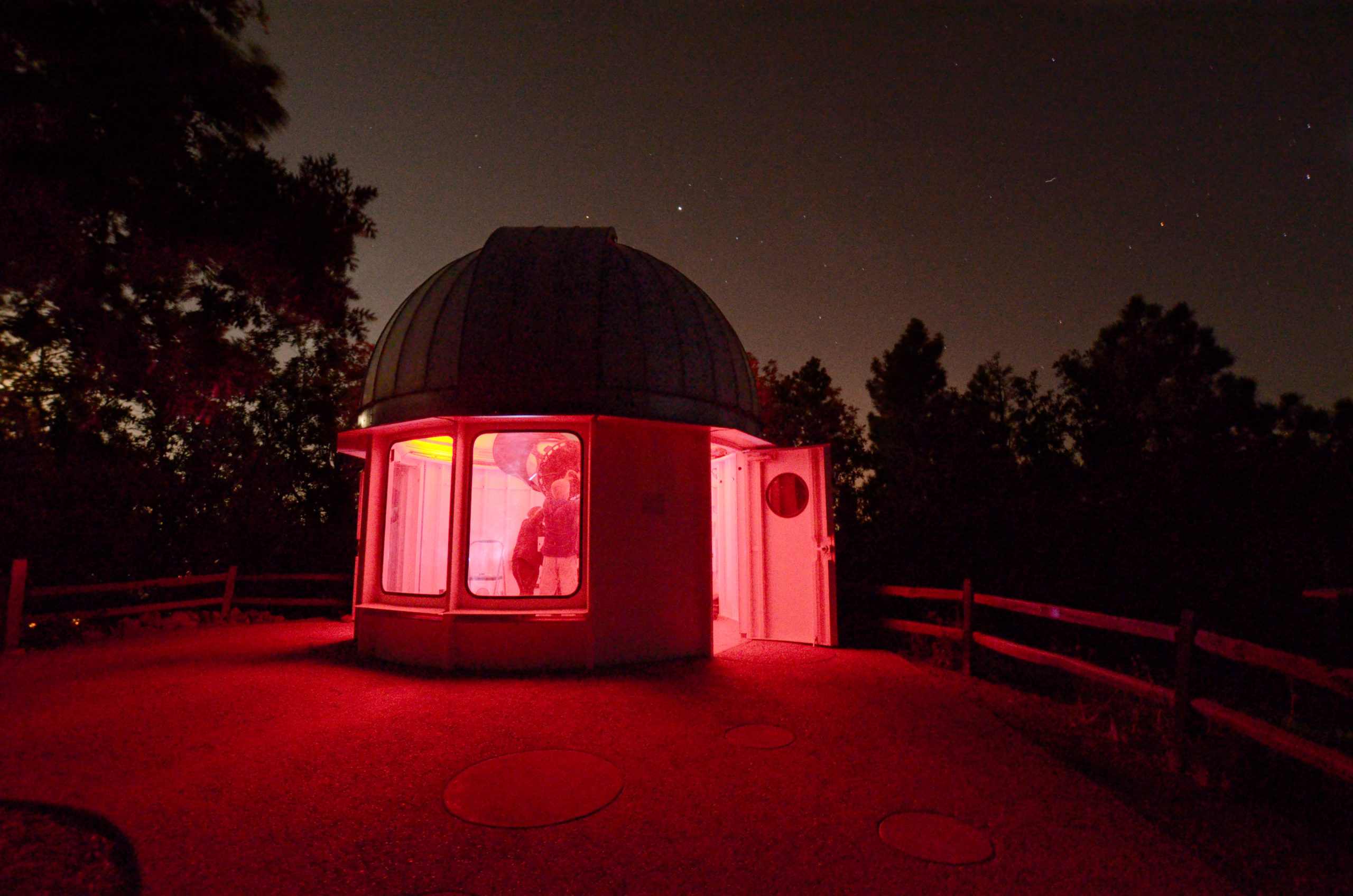
Premium Access: 24″ Dyer Telescope
Daily except Tues.
Start times change monthly, see schedule below
$575 (flat rate) Up to 10 guests
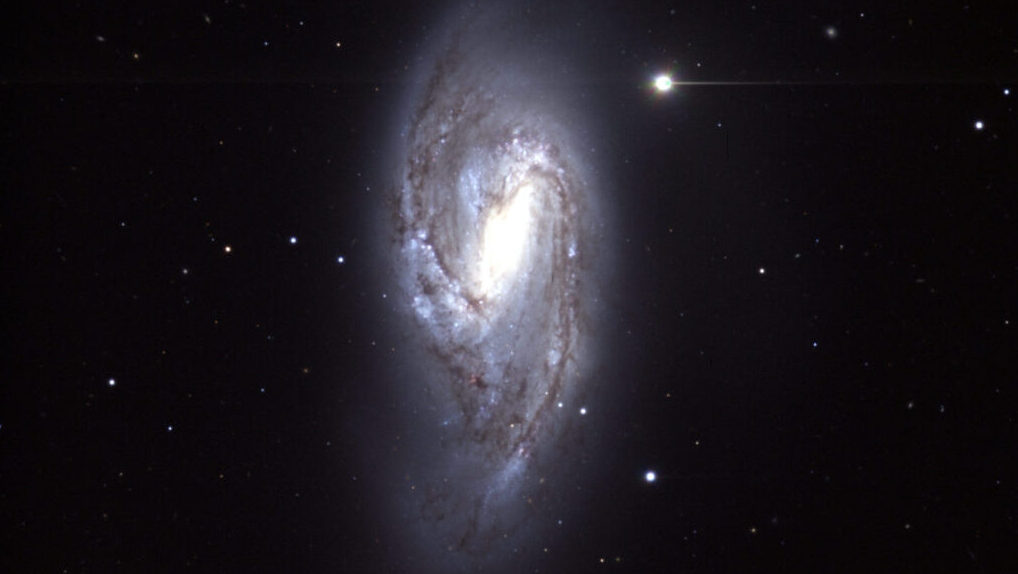
Astrophotography Courses
Most Tuesday Evenings
What to Expect
Learn more about how to plan for your visit.
April 5, 2024
It’s Not Just You: Three Times Eclipses Left Scientists ‘More or Less Agog’
Total solar eclipses have set the stage for major scientific advancements—everything from the discovery of helium to the testing of Einstein’s general theory of relativity.
By Rachel Feltman , Clara Moskowitz , Lee Billings & Madison Goldberg
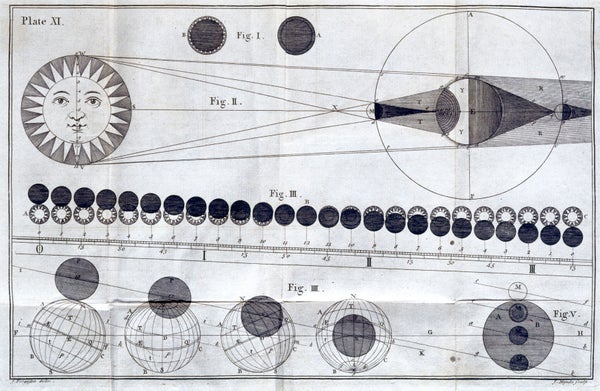
"Astronomy Explained upon Newton's Principles" from 1756.
SSPL/Getty Images

This article is part of a special report on the total solar eclipse that will be visible from parts of the U.S., Mexico and Canada on April 8, 2024.
Rachel Feltman: Hey, listeners. As you may have noticed, we’ve been pretty excited about the eclipse over here at Scientific American .
Lee Billings: I—I am super excited. I’ve got my eclipse pants on, guys.
On supporting science journalism
If you're enjoying this article, consider supporting our award-winning journalism by subscribing . By purchasing a subscription you are helping to ensure the future of impactful stories about the discoveries and ideas shaping our world today.
Clara Moskowitz: Uh, Lee, I’m pretty sure you’re supposed to be wearing eclipse glasses. You can actually wear your usual pants.
Billings: But the e-mail—the e-mail I got specifically said eclipse pants.
Moskowitz: Yeah, you’ve been led astray. Your eyes are gonna be burning, and everybody’s gonna be laughing at your pants.
Feltman: [Laughs] Oh, no. Well, we know that you’re probably just about ready to hear about some other cool science. So we’re capping off our pre-eclipse coverage with one last little solar symposium. Today we’re talking about three times eclipses have totally transformed science. I’m Rachel Feltman, a new member of the Science, Quickly team.
Moskowitz: I’m Clara Moskowitz, an old member of the Science, Quickly team.
Billings: I’m Lee Billings. I am also a bit long in the tooth. But maybe we’re at the point where everything old becomes new again? Yeah, I’m gonna go with that.
Feltman: [Laughs] You guys are too much. You’re listening to Scientific American ’s Science, Quickly podcast.
[CLIP: Theme music]
From the discovery of new elements to the testing of novel theories of gravity, solar eclipses have helped spark scientific progress for centuries. In Scientific American ’s special report on the April 8 total solar eclipse, Paul M. Sutter, a visiting professor of physics and astronomy at Barnard College at Columbia University, laid out three of the most transformative moments in eclipse-enabled science.
Billings: Now, before we get into it, we should clarify that we’ll be listing these scientific discoveries in chronological order, not in order of importance.
Feltman: Yeah. Great point, Lee. Do not come for us in the comments. We’re not here to argue over the value of helium versus general relativity—at least not today. Clara, why don’t you kick us off with gravity?
Moskowitz: Right. So a total solar eclipse played a defining role in establishing Isaac Newton’s theory of gravity.
[CLIP: “Baroque Hornpipe,” by Traditional ]
Picture yourself back in the late 17th century, when scientists are still trying to figure out why the planets move through the sky the way they do.
At that time, scientists had Kepler’s laws of planetary motion, which worked super well to predict the movements of the planets. But the thing was, nobody really knew why they worked. They’d been derived from observational data, not from a fundamental theory of the underlying process. So several researchers had tried to work out the solution, but no one could.
So along comes this astronomer and mathematician named Edmond Halley. You’ve probably heard of him from the comet named after him: Halley’s Comet. He went and asked Isaac Newton about this problem. And Newton basically said to Halley, “Oh, yeah, I totally figured that out. Yeah, it’s—it’s solved. No worries. But I did lose my notes about that.” [Laughs] Uh, yeah.
So nobody really knew if Newton had a solution. But Halley was really excited, and he encouraged Newton to write down how it all worked. And then—even more important—he actually paid for it to be published.
And the result was what basically everybody acknowledges is one of the most important scientific books that’s ever been written, which was Newton’s [ Philosophiæ Naturalis ] Principia Mathematica .
Billings: Was Halley, like, the first—the first Newton stan?
Moskowitz: Yeah, he was a superfan. But we have superfans to thank for preserving the great work of Newton, who couldn’t be bothered to write down his notes about his theory of gravity.
Feltman: [Laughs] Relatable.
Moskowitz: So to cap it all off, Halley was the one who actually proved that Newton’s laws worked because he used them to pretty accurately predict that the eclipse would pass over London on May 3, 1715. And when it did, Halley and Newton were both proved right. So booyah.
Feltman: Wow, I had no idea that Newton needed, like, so much help to get this done.
Moskowitz: Right, he’s like that kid in the class who got the right answer, but he’s like, “What, you want me to show my work?”
Feltman: I’m very sorry for what I’m about to do. But on a lighter note, we’ve also got a total eclipse to thank for the discovery of helium—or, at least, our first observation of it.
Billings: Aha, I see what you did there—very clever. It’s a light gas, that helium.
Feltman: [Laughs] Yes. So this takes us forward a little bit in time to the total solar eclipse on August 18, 1868. A bunch of scientists traveled to observe this one; they were scattered across southern India and Southeast Asia. Fun fact: according to the Thai Astronomical Society, this event was known as the “king of Siam’s eclipse”—not quite our SciAm but close.
Billings: I was gonna say, I wasn’t alive then—come on. Okay.
Feltman: [Laughs] Anyway, researchers were particularly jazzed for this eclipse because they thought it was a really good shot for trying out this hot new scientific technique called spectroscopy.
[CLIP: “The Farmhouse,” by Silver Maple ]
They’d figured out that splitting light into a spectrum of all the colors that made it up could reveal what elements were hiding in there. At the time it was basically just, like, playing with prisms, playing with crystals, really—making rainbows.
The sun made a compelling target for spectroscopy, seeing as it was a big, powerful, mysterious source of light that most of us can see for roughly half of our lives. Researchers were especially interested in solar prominences, otherwise known as filaments, which are these giant looplike structures of incandescent ionized gas that project out from the chromosphere of the sun into the corona.
This is like the fiery crown that pokes out from the sun. When you’re doing a little picture of a sun, and you make the things that stick out, that’s what we’re talking about.
And they realized that a total eclipse would make it way easier to study these filaments by essentially blocking out the rest of the sun’s light so that, you know, you got some good contrast to observe the spectral footprint of these filaments.
Sure enough, pointing a spectroscope at the eclipse—by the way, at the time, a spectroscope was basically a telescope with, like, crystals strapped to it—it revealed something brand-new.
Basically there was this line of yellow light that you might easily have mistaken for the yellow light produced by sodium using a spectroscope, but it didn’t quite match that spectral fingerprint. So this unique wavelength suggested the presence of a previously unknown element within the sun.
Billings: A mystery.
Feltman: Yes. And this was the first time—and, at least right now, the only time—an element was discovered extraterrestrially before it was found on Earth, which is so cool but also, understandably, led to a lot of skepticism. They were like, “Oh, so you found, like, an alien element up in the sun,” [laughs]. [That] was kind of the general vibe from other scientists.
But it makes sense in hindsight that this was observed first up in the heavens because helium is thought to be the second most abundant element in the universe, but it’s exceedingly rare on Earth itself. So [it’s] not surprising that we first encountered it somewhere else.
But helium would only actually be formally acknowledged as an element about 30 years later, which was after another scientist identified it within a chunk of uranium ore and showed that, in fact, it was very terrestrial, just also very rare. They named it using the suggested name from that old eclipse discovery: “helium,” from the Greek word helios, meaning “sun,” to remind us all where it came from.
Moskowitz: So a cool little side note on this: that may be the only element that we’ve discovered off of Earth, but scientists are actually discovering tons of new molecules off of Earth all the time. This is a field that’s pretty big now called astrochemistry, and I’m just a big nerd about it because I think it’s so awesome.
They keep finding these spectroscopy signals up there of things that they don’t know what the hell it is. And they’re like, “Oh, my God, it’s a new molecule.” So there’s all these molecules out in space that we have no idea what they are because they don’t show up here on Earth.
Feltman: I love that. So last but not least, we’ve got general relativity. How did eclipses help us understand that one, Lee?
Billings: So I just want to get out of the way out up front that this facet of solar eclipse science lore led to what’s still my favorite news headline of all time, from the November 10, 1919, edition of The New York Times :
“LIGHTS ALL ASKEW IN THE HEAVENS; Men of Science More or Less Agog Over Results of Eclipse Observations.”
Moskowitz: Classic.
Billings: Right? I mean, it’s the “more or less agog” that really gets me.
Moskowitz: Yeah, because can you be more or less agog, or can you only be agog or un-agog?
Feltman: Yeah, I have to say, I think you can either be agog or un-agog [laughs].
Moskowitz: It’s a binary.
Billings: Yeah, I think it’s a binary distinction here. And maybe you can see where this is going because, again, we already talked about the triumph of Newtonian physics with Halley’s eclipse prediction. But Newton’s gravity didn’t account for everything astronomers could see out there, namely, the precession of the orbit of Mercury—the way that Mercury would twirl around the sun in a way that didn’t quite match up with Newtonian predictions.
Einstein’s general theory of relativity was an improvement here. By considering space and time as one thing, spacetime—probably heard of that before—and treating gravity as the curvature of spacetime from massive objects, Mercury’s odd orbit all of a sudden could be very easily explained.
But if [Albert] Einstein was right, the weighty warping of spacetime should have other observable effects, too. And we needed to make not just a postdiction about something—to explain something we already knew about—but to make a prediction about things that hadn’t been anticipated.
And it turns out, if you look close to the edge of the solar system’s heaviest thing—which is what? All together now!
All: The sun!
Billings: Yes, yes, yes. You should see background stars shifted slightly out of place due to their light being warped around our star’s great spacetime-bending bulk. Without a sophisticated space telescope, the only feasible way to do that back in the early 20th century was using a total solar eclipse, for the reasons we’ve already talked about: it blocked out all the star’s light—all the sun’s light so you could see faint things around it.
Astronomers actually had years of bad luck trying to test this prediction at eclipses around the world. Maybe they were just using it as an excuse to go globe-trotting? I mean, I don’t know. They’re always going fancy places, those astronomers.
Feltman: [Laughs] Yeah, we just need more data! Yeah, I did see that a couple of the expeditions involved in discovering helium had a combined bill of 75,000 francs.
Billings: Back then.
Feltman: Yeah, back then. So I do think it probably was a great excuse to be like, “There’s simply—you can’t put a price on this science” [laughs].
Billings: “And we really need to go to this lush tropical island. Oh, wait, there’s one going on Greenland. You know what—you know what, that one’s actually....”
Feltman: [Laughs] You gotta go.
Billings: “The stars just aren’t aligned. We can’t do it in Greenland.” So, yeah, as I said, they had lots of bad luck gallivanting all around the world trying to verify this prediction. But they finally succeeded in two expeditions: one to the island of Príncipe and another one to Brazil. May 29 of 1919—that was the eclipse that they looked at. And they saw that the offsets of the sun-adjacent background stars were just as Einstein had predicted. And the rest, as they say, is history.
Moskowitz: Well, I’m agog.
Feltman: [Laughs] Quite. So what kind of stuff do modern scientists study when they get the chance to go peep a total solar eclipse, hopefully not having to spend 75,000 francs to get there?
Billings: One thing that they do a lot is: they focus on the sun’s corona, which we’ve already talked about.
[CLIP: “Without Further Ado,” by Jon Björk ]
That’s the diaphanous, glowing, silvery crown of light that seems to suffuse the space around the sun during totality, when the moon slides into place right over the sun’s disk and blots out all that light.
So normally, you can’t see the corona, just because it’s so much dimmer than the sun’s actual radiant surface. But just because you can’t see it doesn’t mean it’s not important.
The corona is a huge, complex, ever changing puffball of plasma around our star, and it fluffs out at its edges to create the solar wind, which forms a protective, cosmic-ray-blocking bubble, or barrier, around our solar system [makes an explosion sound]. That’s—that’s your mind being blown.
But the corona isn’t all sweetness and light. It does have some nasty parts. It can burst out, or burp out, giant clumps of itself that we call coronal mass ejections, which can cause really, really nasty—really nasty, guys—really nasty solar storms on Earth.
So scientists want to study the fine details of how the corona works to figure out what makes it tick and to better understand how the sun makes most of the space weather that shapes our entire solar system as well as our planet.
Moskowitz: Totally. I mean, the corona’s definitely the big one that scientists are trying to study. But there’s a lot of other things, too. I know of a fun project called SunSketcher, where scientists are recruiting regular people all along the path of totality to take pictures of the eclipse on their phones in an attempt to make the most accurate prediction yet of the shape of the sun, which is, of course, a total mystery. We don’t know the shape of the sun, right?
Billings: Is it a rhombus?
Moskowitz: Triangular?
Feltman: [Laughs] I’m not supposed to look at it, so I don’t know!
Billings: Dodecahedron.
Moskowitz: [Laughs] Well, it—we all know it’s basically spherical, but it’s not exactly spherical, is the point. So if they can measure these small deviations from roundness, they can actually get a much better picture of the kind of physics that’s going on inside the sun, which is pretty cool.
Feltman: And then there are eclipses that involve stars other than our sun. Lee, I know you love talking about transit research.
Billings: Oh, thank you so much. You know I do. You know I do. I’m that guy at the party. You don’t want to talk to me about this at the party. So the thing to remember is that every time a star’s light is blocked, that’s technically an eclipse. So this can happen for all stars, right, not just our sun. And I’m not just talking about a total eclipse either, like when a moon casts a shadow on a nearby planet and completely blocks the view of a star, although I’m sure that happens out there a bunch, too.
I’m talking about when an orbiting planet or a moon or, heck, even a comet or some asteroids or Saturn-like ring systems, when they cross the faces of their stars as seen from our solar system, from Earth, and they cast a shadow toward us. Now that’s a transit. It’s really just an eclipse, though.
And it turns out, we’ve gotten really, really, really good at measuring those transitory shadows, those little dips in starlight from some object blipping across a distant star. And that’s how we’ve discovered thousands and thousands and thousands of exoplanets, and some of those exoplanets are about the same size and same orbit even as Earth.
And what’s really cool when you think about that is, as a bonus, if you look at some of the starlight that’s shining through the edges of these exoplanetary silhouettes very, very carefully, you can sometimes measure what exactly is in the atmosphere, what sorts of—of molecules exist there that the starlight’s interacting with. So we’ve talked about spectroscopy, using the crystals to make the rainbows to get the elemental fingerprints, right, right? So it’s the same sort of thing here, and you can see stuff like oxygen or carbon dioxide or water vapor or methane. And that can tell you a lot about whether or not a planet way, way, way out there might be much like the one that’s right here.
And it maybe someday can even tell us whether or not there are living things looking up at our sun as a distant point of light in their own night sky. And that’s a pretty humbling, awesome thought.
Science, Quickly is produced by Rachel Feltman, Kelso Harper, Carin Leong, Madison Goldberg and Jeff DelViscio. Today’s episode was hosted by Rachel Feltman, Clara Moskowitz and me, Lee Billings. Elah Feder, Alexa Lim and Madison Goldberg edit our show, with fact-checking from Shayna Posses and Aaron Shattuck. Our theme music was composed by Dominic Smith.
Feltman: Don’t forget to subscribe to Science, Quickly wherever you get your podcasts. For more in-depth science news and features, go to ScientificAmerican.com. And if you liked the show, give us a rating or review.
Billings: For Scientific American ’s Science, Quickly , I’m Lee Billings.
Moskowitz: I’m Clara Moskowitz.
Feltman: And I’m Rachel Feltman. See you next time.
The 2024 solar eclipse was a teachable moment in more ways than one
What happens when a total solar eclipse trip turns into a college prep experience?
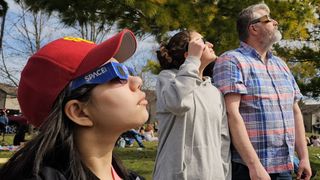
POTSDAM, N.Y. — At first, it seemed like every other college orientation session happening in universities across the country.
A handful of prospective students, my teenage daughter Zadie included, listened intently on the eighth floor of the administration building here while an admissions official shared all the amenities that the State University of New York Potsdam has to offer. In the back of the room, near me, were current university students ready to share their college life experiences. A two-hour tour lay ahead for all of us.
But throughout the presentation ran an undercurrent of excitement. After all, after the tour, we'd see something special: the 2024 total solar eclipse . It was the only time the moon would blot out the sun in the village of Potsdam until the year 2399. That's why my daughter, friends and I drove six hours from New Jersey through New York's Adirondack Mountains to this small college town of 15,000 people.
Well, that's part of the reason. The other? College prep.
Related: These solar eclipse 2024 photos from our readers are amazing
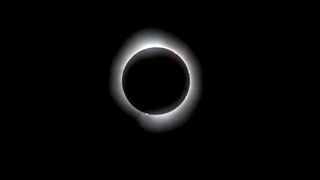
I learned about the school's eclipse festival from friends with ties to the SUNY college system who spotted that SUNY Potsdam was renting out empty dorm rooms for eclipse chasers. We thought it would be a great introduction to college life for our daughters, both of whom are 15, as they start thinking about their future beyond high school. My daughter technically had school on April 8, but I pulled her out to see the eclipse.
"What a perfect event to have a solar eclipse on our campus," SUNY Potsdam President Dr. Suzanne Smith told me after the orientation session, adding that she had actually seen a total solar eclipse once before in 2017 while living in Oregon. "As soon as we learned that we were in the path of totality, we started making plans because we want to show off our campus. We want to show off our faculty and staff. We want to bring potential students to our campus and find ways for our students to do things that are different that they may not see otherwise."
Get the Space.com Newsletter
Breaking space news, the latest updates on rocket launches, skywatching events and more!
SUNY Potsdam has about 2,500 students, most of whom were just returning from spring break on April 8, spread across its schools of Arts & Science, Education and Professional, and Crane School of Music. Classes are small, with a ratio of 11 students per teacher, per the university's profile . Unlike nearby Clarkson University, which gave students just the afternoon off for the eclipse, SUNY Potsdam canceled classes entirely for the celestial event. The university even invited its alumni (and pretty much anyone else) to rent out 90 old dorm rooms for just $60 a night, a bargain when compared to nearby hotels going for $370 a night, but you did have to bring your own linens.
"We really wanted to make this a time that we can just come together and celebrate an amazing experience and be together as a community," Smith said. In addition to opening its doors to prospective students, SUNY Potsdam organized an afternoon of school events, including live music, tours and demonstrations to show the eclipse's effects on plants, animals and, well, the rest of us in totality .

With that, we bunked up in SUNY Potsdam's Knowles Hall North dorm for the event. While my friend Ethan Wheeler and his daughter Catalina brought full sheets and blankets, Zadie and I opted for sleeping bags and pillows to cut down on laundry afterward. It was "cool" to see what life might be like as a college student, Zadie said.
"But like, if I was going to be here for a full semester, I probably would have brought sheets," she added. Maybe a fan, too. That room ran a bit hot.
At first, Zadie wasn't thrilled when I told her we'd be going to college orientation as a sort of pre-game for the solar eclipse . But after touring the school's art and science departments and main library — where we met Ted, a tiny pup who serves as SUNY Potsdam's "Morale Officer" dog — she warmed up. Maybe because Ted's handler was giving out buttons showing the dog wearing solar eclipse glasses .
"This is a nice school," Zadie told me after leaving the library. "There's a lot more to do here than I thought, and I like that the classes are small."

But what of the main event? After all, we were here for a total solar eclipse.
That came at the end of the campus tour, when we joined the hundreds of spectators who had flocked to a school park with a band shell to watch the moon block the sun. A thin layer of clouds had persisted over Potsdam for much of the day, but it did not tarnish the truly spectacular views as the moon eclipsed the sun, leaving us all in awe (and in darkness) for 3 minutes and 14 seconds as its shadow passed over the crowd.
My daughter applauded and cheered, as did we all. In tanks nearby, a group of young quail, two turtles and a nocturnal gecko got very confused.
"The quail thought it was night and went to roost and sleep, and the gecko woke up and was walking around," Zadie said later after asking Dr. Sarah Sirsat, an assistant professor of biology for SUNY Potsdam who brought the animals out, what happened to them.
Related: April 8 solar eclipse: 6 zoos in totality — and why animals react strangely
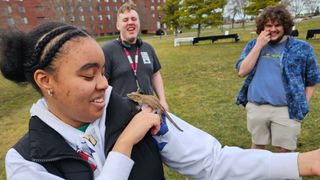
Watching the sun disappear into darkness, and its corona , or outer atmosphere, illuminate a ring around the sun, thrilled the SUNY Potsdam crowd, which cheered as darkness fell and temperatures dropped briefly.
"It was an absolutely amazing experience," our campus tour guide Zachary Byrd, a 22-year-old junior studying public health, said when I caught up with him later. "I was just very star-struck looking at it … it was so cool to see, and I'm glad I got to experience this."
Related: I proposed under the diamond ring of the 2024 total solar eclipse

"I was in tears because of the sense of community that was here," said Smith, SUNY Potsdam's president. "Just people from the campus, people from all over the country, here celebrating together enjoying our beautiful campus that we have, an extraordinary event … It doesn't get much better than this."
Alexandra Jacobs Wilke, the village mayor and director of public relations for SUNY Potsdam, was also in tears. She and her husband brought their two young daughters, Edith, 7, and Matilda, 5 (and the family dog Bijou) to watch the eclipse with the college crowd. "At first we thought that the crowd might not turn out, but we were just so happy to see such different folks from different walks of life," Wilke said.
— Which places on Earth witness the most solar eclipses?
— How the supersonic Concorde jet broke the record for the longest total solar eclipse in history
— When is the next solar eclipse?
Some human observers were also a bit flummoxed during totality. Freshman business student Diamond Cromwell, 18, almost missed it entirely. He was standing behind our group as the sky darkened under the moon's shadow.
"I can't see anything," we overheard him saying during totality.
"Oh! You can take your glasses off now!" my friend Ethan called out.
Cromwell snatched the protective solar eclipse glasses off his face and whooped in amazement.
"It was super unreal, I didn't expect that," Cromwell told me after the eclipse. "It definitely blew my expectations out of the park."
Our group was similarly moved.
"That was gorgeous; that really was quite an experience," my friend Ethan Wheeler of Selkirk, New York, who drove with us to the eclipse, told me later. "I'm glad I got to be here." "That was beautiful, one of the best things I've ever seen," added his daughter Catalina, age 15.
Zadie ended with possibly the biggest understatement of the day.
"It was nice," Zadie said, comparing it to the partial solar eclipse she witnessed from New Jersey in 2017. "The last one, it didn't even cover half the sun! That was cool."
And despite the clouds, the long hours on the road and the longer hours ahead of us, there were no regrets.
"Still, we saw it!" she said as we prepared for what would be a nearly nine-hour drive home due to traffic. "Of course it was worth the drive."
Submit your story photos! If you captured a photo of the April 8 total solar eclipse or any of these strange effects and would like to share it with Space.com's readers, send photos, videos, comments, and your name, location and content usage permission release to [email protected] .
Join our Space Forums to keep talking space on the latest missions, night sky and more! And if you have a news tip, correction or comment, let us know at: [email protected].

Tariq is the Editor-in-Chief of Space.com and joined the team in 2001, first as an intern and staff writer, and later as an editor. He covers human spaceflight, exploration and space science, as well as skywatching and entertainment. He became Space.com's Managing Editor in 2009 and Editor-in-Chief in 2019. Before joining Space.com, Tariq was a staff reporter for The Los Angeles Times covering education and city beats in La Habra, Fullerton and Huntington Beach. In October 2022, Tariq received the Harry Kolcum Award for excellence in space reporting from the National Space Club Florida Committee. He is also an Eagle Scout (yes, he has the Space Exploration merit badge) and went to Space Camp four times as a kid and a fifth time as an adult. He has journalism degrees from the University of Southern California and New York University. You can find Tariq at Space.com and as the co-host to the This Week In Space podcast with space historian Rod Pyle on the TWiT network . To see his latest project, you can follow Tariq on Twitter @tariqjmalik .
Solar eclipse 2024: Live updates
Why I watched the solar eclipse with my kids, a goose and 2,000 trees
What's left of the 2024 solar eclipse lives in our hearts
Most Popular
- 2 Uranus and Neptune aren't made of what we thought, new study hints
- 3 Exotic 'Einstein ring' suggests that mysterious dark matter interacts with itself
- 4 Boeing Starliner spacecraft rolls out to Atlas V rocket ahead of 1st astronaut launch (photos)
- 5 'Star Trek: Lower Decks' Season 4 blasts onto Blu-ray and DVD on April 16
Solar Eclipse Captivates Campus, Guests
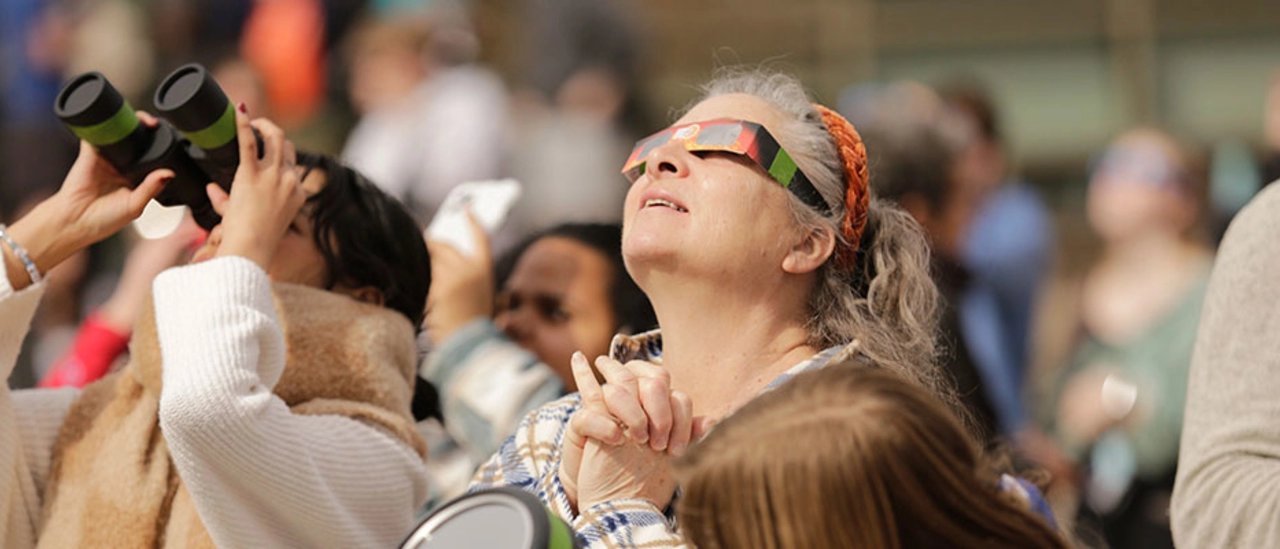
Approximately 3,000 SUNY Oneonta students, staff and community members came together on Monday, April 8, to watch the highly anticipated total solar eclipse on campus.
Donning special protective sunglasses, eclipse watchers of all ages turned their eyes to the skies while seated in lawn chairs, sprawled out on blankets and grassy patches, and huddled together in the President's Garden outside of Chase and the Milne Library.
From about 2 p.m. to 4:30 p.m., they took turns looking through solar telescopes, snapped selfies with mascot Red (who wore a jumbo pair of eclipse glasses) and cheered as the moon slowly passed between the earth and the sun, significantly darkening the sky and lowering the temperature of the air.
Inside the A.J. Read Science Discovery Center, visitors watched NASA’s livestream of totality and participated in space-themed experiments and activities. Science Discovery Center student helpers, dubbed “Celestial Guides,” counted 2,200 visitors and said they gave away 1,500 pairs of glasses. (Throughout the month of April, the Science Discovery Center will collect eclipse glasses, to be recycled and donated to school-aged children in South America so that they can enjoy an eclipse that will be visible there in October.)
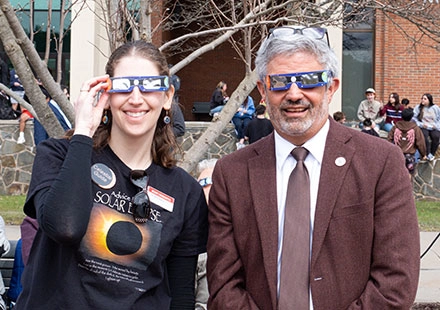
To prepare for the special total solar eclipse, the A.J. Read Science Discovery Center created eclipse-themed exhibits, held themed shows at the Campus Planetarium, and hosted “The Laugh of Totality,” a science comedy show, on Sunday. Assistant Professor of Physics and Astronomy Valerie Rapson demonstrated the importance of eclipse glasses in a series of informational social media videos, including one to show what happens when you expose an eyeball to unfiltered sunlight!

A total solar eclipse won't be visible again from the contiguous United States until Aug. 22, 2044.
View more photos from the event
In the Path of Totality
Some Red Dragons went the extra mile to view the solar eclipse from the path of totality. Associate Professor Dr. Joshua Nollenberg traveled with three of his physics and astronomy students to Cumberland Bay State Park, just outside of Plattsburgh, NY, to view the eclipse, setting up one telescope for imaging and another for viewing. They met up with two Oneonta alumni, saw the eclipse through high cirrus clouds, took photos, and enjoyed music coming from the adjacent Plattsburgh City Beach, which was hosting an eclipse-viewing party and concert.
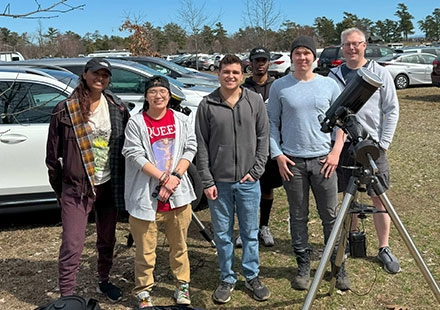
View more Path of Totality Photos
Meteorology Club Travel
Five student members of the campus Meteorology Club traveled to Watertown, NY, to watch the eclipse there.
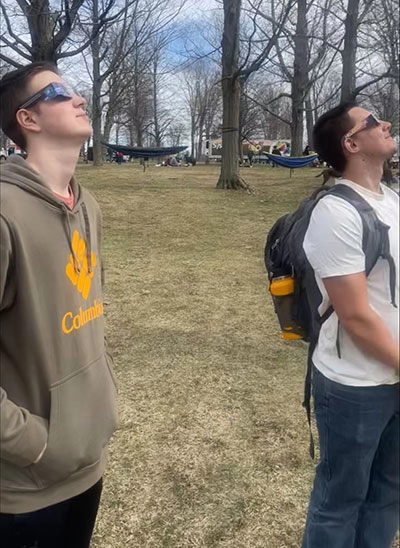

IMAGES
COMMENTS
Visiting for the Ningaloo Total Solar Eclipse? Join the Eclipse Discovery Tour and experience Western Australia's world-class dark night sky. 0427 554 035 [email protected]. Facebook; X; Facebook; X; ... Incredible stargazing experiences are just around the corner. Astrotourism Map. Contact. 0427 554 035 [email protected] ...
For over 20 years, TravelQuest International has been the worldwide leader in total solar eclipse tours and astronomy-themed travel. Click Here for COVID-19 Travel Updates from TravelQuest US 1-800-830-1998; 1-928-445-7754; Sign In; Explore. All Upcoming Tours; Wonders. ... The spirit of discovery has defined Spain for more than six centuries ...
The Eclipse Discovery Tour dark sky stargazing events are planned to coincide with the weeks around the Ningaloo Total Solar Eclipse. Events begin on 25th March with the first stargazing night in Three Springs and the final event in Narrogin on 28th April. During the month-long celebration, events will cover four regions and visit towns such as ...
On a stargazing cruise, the captain will dim as many of the ship's lights as is legally permissible. On the ocean, the night sky is incredibly dark. The stars, constellations, and even the Milky Way shine forth, much as in ancient times. On eclipse cruises in the South Pacific, the Paul Gauguin serves as our floating observing platform.
Travel with the Leader in Astronomy-themed Tours At Sky & Telescope, we have a passion for astronomy, and we want to share it with you in as many ways as possible — including bringing you with us on astronomy tours around the world! Sometimes we board a ship or fly to Africa to see a solar eclipse. Other times we travel to polar countries to see the Northern Lights, or we follow in the ...
The Eclipse Discovery Tour dark sky stargazing events are planned to coincide with the weeks around the Ningaloo Total Solar Eclipse. Events begin on 25th March with the first stargazing night in Three Springs and the final event in Narrogin on 28th April. During the month-long celebration, events will cover four regions and visit towns such as ...
An annular solar eclipse is typically of limited interest even to committed eclipse-chasers, but on October 14, 2023, this "ring of fire" will be visible from some of the most alluring landscapes in North America. For a maximum of 5 minutes, 17 seconds, it will be possible to see a ring around the new Moon from a wider-than-average track ...
Mingenew Dark Sky Stargazing Night. This event is over. Mingenew Recreation Centre. Join us 13 April for an enchanting evening under the stars! The Mingenew Dark Sky Stargazing Night is part of the Eclipse Discovery Tour, a series of stargazing events around Western Australia celebrating the Ningaloo Total Solar Eclipse.
Observatories and organized stargazing. Stargazing road trips: Suggested itineraries. 1. Sin City to the Mile High City. 2. Trail of the Ancients and archaeoastronomy. 3. Skiing and stargazing in ...
Stargazing Discovery Tour to promote dark sky tourism to eclipse chasers Astrotourism WA has released a series of 22 dark sky stargazing events to celebrate the Ningaloo Total Solar Eclipse and promote Western Australia's world-class night sky to eclipse chasers and visitors from around the world.
Join us for Total Solar Eclipse: Texas —a curated experience designed to give you an extraordinary total eclipse viewing location and a once-in-a-lifetime adventure. Join us April 5-9 for a 4-night adventure through Texas—one of the few locations on Earth where the eclipse shadow will be cast. Over the course of your journey, you'll ...
March 1 - 3, 2024. Death Valley offers some of the best stargazing in America. The International Dark-Sky Association has designated Death Valley National Park a Gold Tier Dark Sky Park, which is the highest rating of darkness. During our annual spring Dark Sky Festival, visitors are invited to come explore the night sky and the unique park ...
Here are five luxury stargazing experiences across the U.S: 1. Castle Hot Springs, Arizona. When: Sept. 16, October 7. Where: Natural hot springs in the Sonoran Desert. This luxury resort property ...
For over 20 years, TravelQuest International has been the worldwide leader in total solar eclipse tours and astronomy-themed travel. Click Here for COVID-19 Travel Updates from TravelQuest US 1-800-830-1998; 1-928-445-7754; Sign In; Explore. All Upcoming Tours; Wonders. Stargazing; Total Solar Eclipse. ... Our stargazing tours are small-group ...
Total Solar Eclipse Firewalk and Star Party (April 6-9) Where: Luminous Heart Ranchette, Tarpley, Texas. Time and duration of totality: 13:31 CDT, 4 minutes 20 seconds. More information and ...
Astronomy magazine: 50 years and counting. The world's best-selling astronomy magazine offers you the most exciting, visually stunning, and timely coverage of the heavens above. Each issue ...
Beyond the unique sensory experience lies something even more astonishing — a cosmological coincidence of metaphysical significance to human existence and the scientific enterprise. Discovery Institute is pleased, then, to invite you to join us in the Dallas-Fort Worth metroplex on April 7-8, 2024 for a one-of-a-kind eclipse experience ...
Editor. Students and science enthusiasts are invited to catch a real-time look at radio astronomy as scientists explore magnetic hotspots on the Sun during a live, virtual solar eclipse event on April 8, 2024. A massive, 34-meter telescope once used by NASA's Deep Space Network to communicate with spacecraft will point towards the Sun during ...
5. Find the darkest part of ship. Ship lights are a thorn in the side of avid stargazers, but that doesn't mean you can't see a star-filled sky from the outside decks. "I usually advise guests to ...
Let your imagination get the best of you as you explore the exciting variety of 2024 eclipse opportunities at Eclipse Traveler! Astronomy and exploration are at the heart of our all-inclusive solar eclipse 2024 packages, and together with the best local guides in the world, we hope to share our passion for astral exploration with every adventurous traveler in search of an unforgettable viewing ...
Coinciding with the eclipse-watching event was a groundbreaking ceremony for a new science facility for IDSDC. With construction scheduled to begin by the end of the month, the 23,000-square-foot ...
This article is part of a special report on the total solar eclipse that will be visible from parts of the U.S., Mexico and Canada on April 8, 2024.. Total solar eclipses, such as the one set to ...
Help us create experiences of awe and wonder with the Astronomy Discovery Center, opening in the fall of 2024. Support the ADC. Donate & Giving. Membership Volunteer. Donate Now ... All-day access to tours, exhibits, stargazing, science talks, and more. When. Wed - Sun: Noon to 10pm. Price. $29 adults (18+) $19 college students. $17 children (5 ...
Total solar eclipses have set the stage for major scientific advancements—everything from the discovery of helium to the testing of Einstein's general theory of relativity. By Rachel Feltman ...
The moon eclipses the sun in a total solar eclipse on April 8, 2024 as seen from SUNY Potsdam, New York. (Image credit: SUNY Potsdam) I learned about the school's eclipse festival from friends ...
In the Path of Totality. Some Red Dragons went the extra mile to view the solar eclipse from the path of totality. Associate Professor Dr. Joshua Nollenberg traveled with three of his physics and astronomy students to Cumberland Bay State Park, just outside of Plattsburgh, NY, to view the eclipse, setting up one telescope for imaging and another for viewing.
CNN —. Play was suspended due to a very special brand of conditions at The Masters on Monday. The total solar eclipse plunged Augusta National Golf Club into darkness shortly after 3 p.m. local ...